

Bosnia: Mountains, Rivers & Mosques
Bosnia-Herzegovina is a beautiful country that has been recovering strongly since the war of the mid 1990s. Amongst its jewels is an abundance of mountains, forests, rivers, waterfalls, hospitable people and 600 years of Islamic civilisation in the heart of Europe.
This heritage tour takes us to places of Islamic, historical and cultural significance in the company of experienced guides. A great opportunity to meet local people and learn more about a truly fascinating region. We begin by exploring the historic city of Sarajevo and reflect on the tragedy of Srebrenica. We then witness the splendours of Mostar and experience the natural beauty of places such as Blagaj, Pliva Waterfalls and Mount Igman.
Our Bosnian guides speak fluent English along with languages as diverse as Arabic, Indonesian and German. They have many years of experience organising tours in the Balkans.
Tour Package
All local transport with airport transfers, accommodation, breakfast, tour guide, entrance fees and local taxes are included. An experienced English speaking guide will accompany the group throughout the trip. Transportation will primarily be in an air-conditioned mini-van or bus. International flights are not included but we will advise you on the best routes from your country of departure.
Highlights:
Baščaršija Area, National Library, Ferhadija, Tunnel of Hope, Vrelo Bosne, Mostar Old Bridge, Svrzo House, Srebrenica Martyrs Cemetery, Pliva Waterfall, Pasha’s Madrasa, Sulejmania Mosque, Jajce Fortress
Main Locations:
Sarajevo, Srebrenica, Travnik, Jajce, Mostar, Blagaj
Addition Locations or Activities for Extended Tours:
Dubrovnik (Croatia), Bihac, Tuzla, White Water Rafting
International flights should be booked in accordance with the dates advertised but you are strongly recommended to confirm these details with us prior to making payment.
Arrival Location: Sarajevo Airport (SJJ) Arrival Date: Saturday 25 May 2024 Arrival Time: Before 17:00 Departure Location: Sarajevo Airport (SJJ) or Dubrovnik Airport (DBV) Departure Date: Saturday 1 June 2024 Departure Time: After 16:00
Accommodation:
A mixture of high quality 3 and 4 star hotels in convenient locations with emphasis on safety will allow you to easily reach the most important attractions. Participants typically spend 5 nights in Sarajevo and 2 nights in Mostar.
Standard accommodation features twin rooms with separate beds but single supplement options are also available.

“I very much enjoyed the trip as Bosnia is a very beautiful and scenic country and I thank the organisers for putting it together. All around I think it was a good trip.” ( Esma, September 2017)
“The Balkans tour gave an amazing oversight of the culture and atrocities that have taken place in Bosnia. The tour was the right amount of sightseeing and relaxation. The tour guide was just amazing and very knowledgeable about Bosnia. We were given a lot of flexibility and the tour guide worked around the group’s wishes. Being a vegetarian, the tour guide ensured that everyone’s dietary requirements were also met. There was so much more to see in Bosnia and 7 days was just not long enough. Wish we had more time in Mostar.” ( Tanveer, September 2017)
“Islamic Travels, Jazak’Allah Khair for giving us the opportunity to travel to Bosnia. It was a much needed and enjoyable break. All in all the overall experience was good alhamdulillah and satisfying. Just thought I leave you some feedback. I found the accommodation very comfortable, there was still more to see and do. An extended package of a few days extra may attract a wider audience in’sha’Allah. The rest was value for money alhamdulillah. The group clicked and the tour guide was brilliant and made us feel comfortable. Logistically everything went smoothly, and there was no pressure on me to sort out anything else as most of it was taken care of. I will definitely recommend this trip and group to others.” ( Abdul Hamid, September 2017)
“Overall the trip was an amazing experience both in terms of the insight into Bosnia’s culture and heritage as well as the travelling group themselves. Our tour guide was extremely helpful and friendly and felt more like a buddy at times. He was very flexible and accommodating, prioritising enjoyment over schedule, was also very knowledgeable on history and religion, which is important for an Islamic heritage tour. We enjoyed local food stops throughout the trip, my overall experience of the trip was overwhelmingly positive. The trip was generally hassle-free from the moment we landed to our departure, I learned a lot more about Bosnia and its very colourful heritage than I expected, and I enjoyed the companionship of like-minded and diverse group of travel buddies which made the whole experience highly memorable. I would certainly consider going on Islamic Travels tours in future and would recommend them to friends also.” ( Raihan, September 2017)
“I was pleasantly shocked at how beautiful and picturesque Bosnia is, the mixture of mountains, rivers, waterfalls, mixed in with culture and history is awesome. Having also travelled to Srebrenica as part of the tour, we were overcome with a deep sorrow but we also felt as a consequence a connection with the people, to support them and tell others about their struggles and their courage to overcome such evil that took place. We could have not gone there but having had the experience this made our connection with Bosnia even stronger. From that experience we were able to see how the people are recovering and rebuilding themselves and their future and that is very humbling. We travelled to different cities including Mostar and Sarajevo. All at once you can be part of the old and the new, and as a Muslim could connect to the Islamic heritage that is there. There are Masjids everywhere, tekkiyas, some are so old, when you walk in you feel a connection to the past. You can only sing the praises of Allah as you travel through Bosnia, and since it is an Islamic tour, there were many tears of joy and wonder at what we saw. We stayed in halal hotels, where no alcohol was sold and we ate at halal restaurants and food stalls. Our female guide Selma was timely, professional and very knowledgeable. She went beyond her duties to provide us with an excellent experience. As we were a female only group I am so pleased that we had a female guide. It made the experience even more easy for us. She was able to understand our likes and dislikes very quickly and even went out of her way to help me go somewhere that was not part of the tour. Sarajevo is an incredibly lively place that both young and old can enjoy. The food is incredibly cheap, and very good quality and organic. Our driver was excellent, he drove so well and safely just like a family member would. We have had some harrowing experiences in many parts of the world, so this was excellent. I have had the privilege of travelling all over the world but Bosnia is a place that has left a resonating effect on my heart, Inshallah I will be going there again. Islamic Travels was extremely professional and I would have no hesitation in recommending them. We wanted an Islamic holiday somewhere we have not been before. Although it was costly (peak season, and last minute) I am really pleased we did this as a family and we learnt so much and enjoyed ourselves. Bosnia is a country every Muslim should travel to.” ( Saleha, August 2017)
“I wanted to visit Bosnia with a focus on the history and culture from an Islamic perspective, travelling with other Muslims. The Islamic perspective, catering for needs of Muslims, e.g. awareness about halal food, visiting mosques and Islamic history sites The guide who was able to share her personal experience which gave us greater insight into the history of the country. The honesty and integrity of the guide as a person. The helpful and safe driver who took us many miles through the beautiful county. The variety of sightseeing tours through landscape, gave balance to the more harrowing visits to Sebrenica, and interspersed with days spent in Sarajevo at museums and other sights. The support offered by the tour guide and hotel staff when one of our party had to return home early. A good overview of the county, its history and people, with regard to the requirements of travelling Muslims.” ( Catherine, August 2016)
“The destination, the itinerary, the guide, the group and the small size of the group. All the elements were there to allow us to spend an amazing time together in a country full of surprises, history and beauty. Because of the destination I didn’t know, the period, and the price corresponded to my budget alhamdulillah. Bosnia and Herzegovina is a must place to go for those who want to learn some history, appreciate natural beauty, eat good and cheap food, meet lovely people…. All that in the same place! Jazakumallah kheir to have organized this memorable trip.” ( Myriem, August 2016)
“Fantastic trip. Well organised, very informed guide and good value for money. Would recommend that more people visit Bosnia & Herzegovina. The scenery is fabulous, the people generous and many, many years of Islamic history.” ( Aysha, August 2016)
“Visiting so many beautiful places, and learning about the history, especially the Ottomans. It was also a pleasure to meet many native Bosnians and learn directly from them upsetting to hear stories about the Bosnian conflict. I wanted to visit a part of the world I knew nothing about. I wanted to see a Muslim country in Europe, learn more about its history and see the beautiful scenery of this undiscovered land. Having been there, I would definitely recommend everyone should visit Bosnia and Herzegovina! This trip affected me deeply and I believe it is essential for all Muslims to visit this region, experience what I did and spread the word (which I will certainly do). Thank you for organising this fantastic tour.” ( Saleema, May 2014)
“The tour guide. She was an important part of the holiday as we spent significant time with her – she was incredibly relaxed, friendly, adaptable and understanding. It was as if we had gone to Bosnia and met an old friend. Her company and expertise certainly enhanced our experience, and I would certainly recommend her specifically to any of my family / friends wanting to go in the future. Also the car was very comfortable and we felt safe with the driver. I have travelled a lot in the past and I chose this country because it was a bit different to the usual holidays and ‘off the beaten track’. The tour itself is the first I’ve done with Islamic Travels. The idea of looking at the Islamic heritage of a place was very appealing. My friend and I thought we would just give it a go and we are glad we did as we enjoyed it thoroughly, so much so we would recommend to all our friends and families and would certainly come back for another visit. The people in the country make the trip and our tour guide Selma, driver Samir and all the other people we were introduced to by them were fantastic and welcoming. They made us feel very safe and were constantly checking for any issues that might compromise our trip, and we were told that the base in London was regularly checking up on us to see if we are ok and enjoying ourselves, which I thought was rather nice.” ( Farah Ahmed, May 2014)
“The Bosnia trip exceeded my expectations, the group was good, Senad, Sehija, Retno and all the others we met were really good people and guides. The contacts our hosts had made the trip all the more interesting and insightful. The accommodation was really good too. I would and have recommended this trip to others and would do another one of these trips insha Allah.” ( Ayesha Fisher, May / June 2011)
“Just a short note to say we had a brilliant time in Bosnia. Great company of companion travellers. Want to say for now that it was great on the whole, and glad we went as both our hosts there, Br Senad and Sr Sehija were just so helpful and friendly.” ( Mumtaz Hussain, May / June 2011)
“We had a lovely trip which exceeded our expectations. We were alhumdulillah in good company -our fellow travellers, and have all become good friends. We learnt a lot about our Muslim brothers and sisters in Bosnia, and found Bosnia-Herzogovina very scenic and historical. I was pleased to meet such friendly and inspiring people. It is unfortunate the we in the UK know so little about what they have suffered and that they continue to face challenges, and could benefit from our support. JazakAllahu khair for organising the trip.” ( Rubina, May / June 2011)
“Learning about the history and current problems of the region from an experienced guide was invaluable. Visiting historical and cultural sites was another highlight. The visit to the memorial site in Srebenica was extremely harrowing but is essential for all who visit the region to gain an appreciation of the bravery of those who have rebuilt their lives after the war. Finally, visiting the Nahla Centre in Sarajevo was truly inspiring because of the huge efforts put in by a few women to turn their vision of a fairer society into a reality. I enjoyed travelling with the tour group and learnt a lot from individuals. I wanted to travel with a group that was familiar with my needs as a Muslim and that would offer me a real insight into the Islamic history of the region. I was also impressed with the details offered on the Islamic Travels official website.” ( Shahien, May / June 2010)
“Unique experience, a must trip for all Muslims who are concerned about the Muslims living in the UK, not just UK but worldwide. Bosnia and its people have demonstrated how to fight the Islamic way. They were very careful and very much aware of how Muslims should fight during the way. A very useful lesson to be learned especially for Muslim counties who are currently fighting wars. Amazing explanation of how the Muslims live in a community and especially the way they have managed to take care of women’s needs. An example for us in the UK to follow. I was blessed to take part in the tour. The people of Bosnia are very kind and keen for Muslims from all round the world to visit them. I strongly believe that all the Muslims should support them in rebuilding their lives and their country and make Bosnia one of the hottest destination for holidays.” ( Nasrin, May / June 2010)
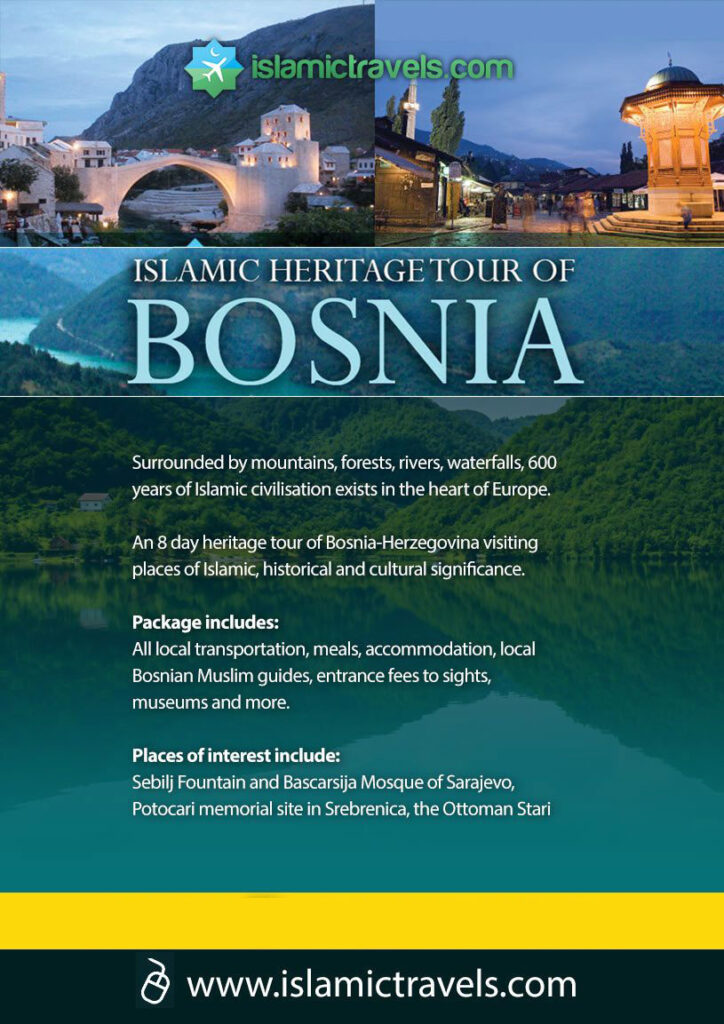
Next tour dates
25 May – 1 June 2024
Enquire about this tour now.

8 Days Halal Holiday
Our 8 days Green Bosnia package offers the best way to explore the most important sites in Bosnia and Herzegovina with the respect of the halal voyage. Booking the 8 days Green Bosnia package is possible everyday during the year. Our travel consultants will give you detailed information about the reservation process and will inform you about the all other small details. This package is the best way to combine all-important cultural and nature centers of B&H. This tour is perfectly designed for easy and comfortable travelling for Muslim travellers or Islamic research makers.
Bosnia & Herzegovina
Halal Package Holiday
All year long
Casual, comfortable clothing, jacket and shoes ( according to season)
From our gallery

Arrival and Accommodation
Welcoming at SJJ Airport, transfer to the hotel on the private basis. Accommodation in the rooms.Orientation tour, basic information about state, city, weather, people, currency and where to eat. Arrangements of timings and schedules for the following day.
Sarajevo Heritage and Nature Tour (Sarajevo Old Town, Bosnia River Springs)
We shall pass Sarajevo’s many cultural and historic sights. We will see the exquisite Ottoman marketplace- Bascarsija- set within mosques, madrassahs, libraries, hostels going back 550 years. As we continue our walk on, we will take in the majestic Austro- Hungarian architecture and landmarks of the communist period, including the City Hall, Post Office and National Library.Our day will be completed by visiting springs of Bosnia River, the untouched nature with dozen of fresh water springs will certainly remind us of the life, gratefulness and modesty.
Tour to the Medieval Bosnian Kingdom
Today we are taking a tour of Travnik and Jajce. Travnik is one of the most important cities in Bosnia. Travnik is a city of great history, in fact, small by area. Upon arrival in Travnik, we will visit the famous mosques in Travnik. And continue to the Old Fortress. The castell offers a breathtaking view of the vizier town of Travnik. After that we will have free time for a cup of coffee in the Blue Water Springs. Before arrival to Jajce we will stop at well-known organic restaurant for lunch. Jajce is described as town made of stone, light and water. It is a royal town and an open-air museum, built on the confluence of two great rivers – the Pliva and the Vrbas. The most recognizable symbol of Jajce is it’s magnificent 17-meter high waterfall (situated at the place where the river Pliva flows into the river Vrbas). The waterfall is in the heart of the town, making Jajce one of the most unique towns in the world. In the afternoon hours we will be back to Sarajevo.
Green Sites Around Sarajevo
Sunrise will bring refreshment and start for new day. Today, we are going to discover the best green sites of Sarajevo Region. Our plan is to show you ways to explore mystical history of BiH and virigin nature in the same time. We will start our day with visit to Bosnian Pyramids’ Tunnels. Our day will be continued with exploring flora and fauna of Sarajevo through visiting the Bijambare location, encompassing 370 hectares, that is recently proclaimed by law as protected area of the fifth grade (“protected landscape”). It is traditionally highly valued area because of its natural beauty and flora and fauna richness. There are plenty of beautiful landscapes for easy family walks in fresh mountain air, but Bijambare is also a favorite place of visit for cyclists, mountaineers, hikers and other nature lovers. Use of cars is forbidden in the Bijambare park and that’s the fact that guarantee visitor’s enjoyment of the outdoors in calm surrounding.
Discovering Herzegovina
Herzegovina is a part of our country of great natural wonders, rivers rich with water and mix of cultures all living under the same sky! Our fist stop will be in beautiful small town, Konjic that is suited one-hour drive from Sarajevo. Beside cultural and natural sights you will have opportunity to entertain your palate with traditional Bosnian sweets. After, Konjic we continue tour next stop. Spring of Buna River and Dervishes house. Buna’s spring is one of the largest and most beautiful springs in Europe, producing approx. 30 m3/s with extremely cold and clean water.We continue our way to beautiful Mostar and UNESCO protected site Old Bridge, the real pearl of Herzegovina region. Old Bridge is one of the country’s most recognizable landmarks; it is also considered one of the most exemplary pieces of Islamic architecture.
Free Time (driver/guide/veheicle is not on disposal on this day)
Day after a long drive can be very exhausting, that is why our travel experts advised free day for you and your family. Today, use a free time to gather some positive energy from the surroundings of Sarajevo vibration; you are staying in the heart of Sarajevo. Don’t forget to be a “little” explorer by yourself because you won’t have on disposal vehicle, driver nor guide.
Prokosko Lake
On this day we should enjoy the nature of Vranica Mountain, where is hidden Prokosko Lake, which is located at altitude of 1635 meters above sea level. Prokosko Lake is 426 meter long and 191 meter wide with maximum depth of 13 meters. With high altitude climate and nice position the lake is considered to be one of the most beautiful locations in Bosnia and Herzegovina. You will be given free time to enjoy fresh air and to discover surrounding nature.
After check out from your hotel, it is time to say until next time to Sarajevo and Bosnia and Herzegovina. With assistance of your driver/guide you will make check in at airport. We are certain that you already packed some good taste of Bosnia “honey” or “pekmez” in your suite bags so good taste of Bosnia will follow you to your home along with beautiful memories!

TOURS - INFO
An amazing tour and lecture on what practicing Islam in Bosnia looks like, how do Muslims live and how they lived through different times and different governments through centuries. The tour will cover everything from the arrival of Islam to Bosnia until today. If you want to get to know Islam and Muslims, their views on life, and how we live today: from prayers to going out. The tour takes place in the old town in Sarajevo and includes a visit to a mosque, tekke (dervish house), a traditional Muslim family house, a cemetery and ends with traditional Bosnian coffee/tea. All questions that you have about Islam and Bosnia will be answered by our informative and patient tour guides.
Duration: 3 hrs
Included: Entrance fee to Gazi Husrev-bey mosque, Svrzo’s house, Bosnian coffee.
A perfect tour to get to know the Muslims and Islam in Bosnia. The tour will walks you around old town in Sarajevo to all the most important places which show the complete life of a Muslim in Bosnia: from traditional houses to mosques, schools, and cafes.
Highest Peak:

020 8004 6786
+447506 408585
Bosnia & Herzegovina

We are ecstatic to announce, Our AUGUST Islamic Heritage package 2024 to Bosnia will be led by Sheikh Wasim Kempson .
Book now for an incredible, spiritual and educational experience!
LIMITED SPACES AVAILABLE
TOUR DATES:
Depart: TBC
Return: TBC
FAMILY FRIENDLY
Join us from many worldwide locations
Scroll down for more details!
Be the first to know!
Thanks for subscribing!
Our Bosnia Heritage tour takes you on a journey through the heart of Bosnia, where you'll visit some of the most important historical and cultural sites in the country. This includes a visit to Sarajevo, the capital of Bosnia, which is known for its mix of Ottoman, Austro-Hungarian, and modern architecture. You'll also explore Mostar, famous for its iconic Stari Most bridge, and visit the Srebrenica Genocide Memorial to pay your respects to the victims of the Bosnian War.
For those interested in Bosnia's natural beauty, we offer a Bosnia Nature tour that takes you to some of the country's most stunning landscapes. You'll visit the Kravice Waterfalls, a series of cascading waterfalls that are often referred to as the "Bosnian Niagara," and explore the Pliva Lakes, a tranquil series of lakes and waterfalls surrounded by lush greenery. You'll also have the opportunity to visit the Vjetrenica Cave, one of the largest and most fascinating caves in the country.
If you're looking for a more immersive experience, our Bosnia Adventure tour offers a combination of outdoor activities such as hiking, rafting, and zip-lining, with visits to cultural and historical sites. You'll explore the stunning Rakitnica Canyon, go rafting on the Neretva River, and visit the medieval fortress of Počitelj.
For a taste of Bosnia's cuisine, our Bosnia Food tour takes you on a culinary journey through the country's traditional dishes and local specialties. You'll have the opportunity to try cevapi, burek, and other delicious foods, while also learning about the cultural significance of Bosnia's cuisine.
Finally, we offer a Bosnia and Herzegovina Highlights tour that combines the best of Bosnia's natural and cultural attractions. This tour includes visits to Sarajevo, Mostar, the Kravice Waterfalls, and other must-see destinations.
To go into detail about what each package includes, contact our team in London.
Basic Tour Details & Inclusions
Most Efficient
4/5* Accomodation
1Piece + Hand Included
GUIDED TOURS
Expert Guides
Full Ground

ATOL PROTECTED
In the oldest European Muslim Country
Safe & Secure Bookings
Free with Hotels
By Sheikh Wasim Kempson
Children Welcome
HOLIDAY TIME
Peak Dates of Travel
Just in case ;)
TRIPLE SHARE
DOUBLE SHARE
SINGLE SHARE
CHILD/INFANT
from TBC pp
Get £50 Off per person
if booked & paid in full by june 05th 2024
Check out the sites we visit on our tours - your ziyarah.

Click image above to view just some of the sites we visit with you

MASJID AL AQSA

EXCITED TO JOIN THE AQSA & Jordan TOUR?
Book your place with Ibadah Tours today. Our team in London will be happy to help you find the right package.
All the flights and flight-inclusive holidays on this website are financially protected by the ATOL scheme. When you pay you will be supplied with an ATOL Certificate. Please ask for it and check to ensure that everything you booked (flights, hotels and other services) is listed on it. Please see our booking conditions for further information or for more information about financial protection and the ATOL Certificate go to: www.atol.org.uk/ATOLCertificate
IBADAH TOURS IS A TRADING NAME FOR MK HOLIDAYS LTD
65b Palmerston Road, London E17 6PR


Bosnia 4 NIGHTS / 5 DAYS
- Holiday Types
- Tour Packages
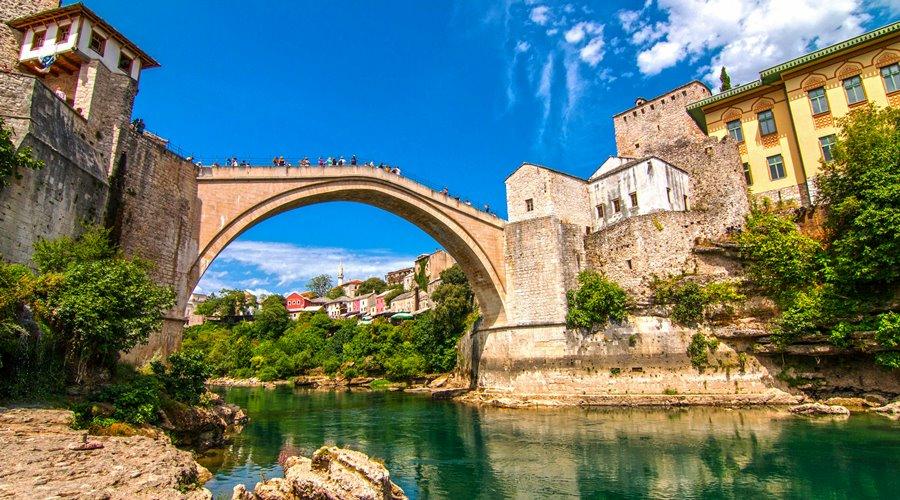
Arrival to Sarajevo International Airport and transfer to the hotel You will arrive in Sarajevo Airport and will be welcomed by one of our staff who will take you to your hotel.
Visiting spring of the river Bosna, Tunnel of Hope and Old Town Bascarsija. On the tour you will discover why it was built in the first place and why it is so important to visit it. After all the history and buildings, it is time to enjoy the nature. Spring of the river Bosnia is the most beautiful and visited park in Sarajevo. There you can enjoy fresh air, numerous water streams, watching birds, fish, swans and ducks. Our next destination is The Tunnel, known as Tunel spasa or Tunnel of Hope. You will see and go through the Tunnel itself, but only for 25 meters. The Ottoman Empire made Sarajevo an important administrative center by 1850. Bascarsija was built in the 15th century when Isa beg Isakovic founded the town and it became and old bazaar and a historical and cultural centre of the town. The word Bascarsija derives from the Turkish language. Vrelo Bosne The pearl of the Bosna river with invigorating air, pleasant atmosphere and a picturesque landscape. Sarajevo The capital of Bosnia and Herzegovina situated in the very heart of the country is one of the most interesting cities in Europe that connects eastern and western world as an excellent example of the city that has never lost its multi-ethnic character in spite of frequent historical turbulences.
Visiting Jablanicko lake, Old Bridge in Mostar city and spring of the river Buna. Mostar is situated on the Neretva River and is the fifth-largest city in the country. Mostar was named after the bridge keepers (mostari) who in the medieval times guarded the Stari Most (Old Bridge) over the Neretva. The Old Bridge, built by the Ottomans in the 16th century, is one of Bosnia and Herzegovina’s most recognizable landmarks, and is considered one of the most exemplary pieces of Islamic architecture in the Balkans. The Buna is a short river in Bosnia and Herzegovina; it is a left bank tributary of the Neretva. Its source (Vrelo Bune), a strong karstic spring, is near the village Blagaj, southeast of Mostar. Actually, it is best known by famous Buna Spring (Vrelo Bune), one of the strongest springs in Europe and extremely cold water. The Buna flows west for approximately 9 km, starts at Blagaj and meandering through villages Blagaj, Kosor, Malo Polje, Hodbina and joins the Neretva at Buna village. The Bunica river is main left bank tributary of the Buna. The Buna river spring Near the old village Blagaj, southeast of Mostar, the Buna river spring flows out of a 200m cliff wall and creates a beautiful, crystal clear, extremely cold and 9 km long river that flows into the Neretva. This place is an important part of a rich cultural and historical heritage of Bosnia and Herzegovina and a site of great tourist attendance. Mostar A historical and cultural center in the western Herzegovina, situated in a green valley along the Neretva river surrounded by the Mediterranean mountain terrain.
Visiting Travnik city, the lakes and waterfalls in Jajce city Travnik is a town and municipality in central Bosnia and Herzegovina, 90 kilometers west of Sarajevo. It was the capital city of the governors of Bosnia from 1699 to 1850, and has a cultural heritage dating from that period. Travnik is located near the geographic center of Bosnia and Herzegovina . The river Lasva passes through the city, flowing from west to east before joining the Bosna river. Travnik itself is built in the large Lasva valley, which connects the Bosna river valley in the east with the Vrbas river valley in the west. Jajce is a town and municipality located in the central part of Bosnia and Herzegovina. The town is famous for its beautiful waterfalls where the Pliva River meets the river Vrbas. It was thirty meters high, but during the Bosnian war, the area was flooded and the waterfall is now 20 meters high. Jajce The old royal city that constituted the fortified capital of the Bosnian Kingdom. Offering beautiful countryside and many attractions to be visited (a medieval fortress with long defensive walls and a large citadel, catacombs, the Pliva waterfalls and lake, watermills), the whole area is geographically and historically interesting. Travnik The town in central Bosnia where was the seat of the Ottoman viziers. The attractive sightseeing locations include the impressive medieval fortress and many other monuments (old part of the town, oriental houses, mosques, tower clock) that mostly dates back from the Ottoman period.
Departure (transfer to Sarajevo International Airport)
Why Book with us?
- Personal service and expert advice.
- First hand knowledge of the destinations we sell.
- High number of repeat customers.
- We offer only the best hand picked luxury destinations.
Alternative dates?
For alternative dates, duration or promotions please call one of our specialists or send an enquiry.
Other Tours in Bosnia

Bosnia 5 NIGHTS / 6 DAYS

Bosnia 7 NIGHTS / 8 DAYS
View all Bosnia tours.

Destinations

Halal Hotels
Inspiration.
24 Places To Visit In Muslim-Friendly Bosnia (Number 14 is Gorgeous!)

Page Contents
With a Muslim population of over 50%, Bosnia is one of Europes most unique destinations for halal-friendly travel. Combining a harrowing history, a rich culture, unique cuisine, and quite beautiful scenery, visitors to Bosnia come back with memories well past their expectations.
Bosnia has a very rich culture and historic heritage dating back to 12,000 BC. The country has seen it all. Roman period; Middle Ages; the Muslim Ottoman period, Austro- Hungarian period and the period between the two world wars. During the aggression war on Bosnia & Herzegovina in the period 1992 until 1995 the cultural heritage suffered extensive damage and a large portion of it was destroyed. Some very important monuments were demolished.
Here are 24 places in Bosnia for you to explore. The country is quite small, but it packs so much along with friendly locals, Muslim communities and some quite beautiful landscapes.
1. Sarajevo
Sarajevo, the country’s largest city, has a population of about 400,000. The city was founded in 1462 by an Ottoman commander Isa-bey Ishakovic. Since its inception, Sarajevo had its first water supply and a public bath. In 1885 the first horse-drawn tramway started operating in the city and 10 years later the electric tramways. Just goes to show how forward-looking the city was.
Sarajevo is surrounded by mountains. Namely, Jahorina, Bjelasnica, Igman and Trebevic. These mountains are places of popular resorts for the citizens of Sarajevo and were also the location for XIV Winter Olympics.

When in Muslim-friendly Sarajevo, a walk through the Old Town is an absolute must. It’s a travel through time, taking you back to the old world charm – cobbled streets, narrow alleys, souvenir shops, chevabi places, baklava (dessert delights) stores, sheesha-smoking joints, kahva houses and of course the mesmerizing landmarks – the Bascarsija, Gazi Husrev-Bey’s Mosque, the Sebilj, Sacred Heart Cathedral, the Orthodox Church and not to forget the Clock Tower that shows time according to the lunar calendar.
Around the Old Town are other famous buildings and monuments. Notably, the City Hall, the Library, Academy of Fine Arts, National Museum, National Theatre, Army House, Principov Bridge, Latin Bridge and the Sarajevo Museum. And for the shoppers in you, there are some malls too.
Set on the banks of River Lasva, Travnik was the capital of the Muslim Ottoman viziers from 1699 to 1851. After the conquest, the Ottomans continued its constructions to convert the town into a strong defensive fort from which they could control the passage in the Lasva valley. Today the Travnik Fort offers panoramic views of the town below and the mountains beyond.
Travnik is the birthplace of the Noble Laurate Ivo Andric. His house is now a museum that showcases Bosnian furniture, various photographs, Travnik chronicles and a library.
Vlasic is a mountain in the very centre of the country. Its highest peak is Paljenik with an elevation of 1,943 metres. The region is famous for its pastures, cattle- breeding and cheese. It is believed that the Romans, around 1,000 years ago, got the cheese recipe into Vlasic. Basically, it’s made from sheep’s milk and then left to ripen for two to three months.
In addition to the cheese, there are two other trademarks associated with Vlasic – the Tornjak dog and Pramenka sheep. The Tornjak is believed to have existed for more than a millennia, bred to guard from wolves and bears. I did have the opportunity to interact with a shepherd and pat a 2-month old Tornjak.
The mountain is a major center for winter tourism due to its excellent accommodation for skiing, snowboarding, and other winter sports. It is also a popular destination for summer and eco-tourism with many hiking trails and pristine wilderness areas.
Tourist settlement – ethno village Cardaci is located in Vitez. With unique surroundings on the banks of the River Lasva, it covers an area of 6 hectares, and includes rich summer and winter offers, as well as hospitality facilities. It’s built exclusively from natural materials, in ethnic style and modeled on the old Bosnian house. Overall the location gives great importance to the past, tradition and family values.
The history of Mostar begins with the Neolithic Age as attested by various archaeological sites. The Old Bridge built in 1566 is today a UNESCO world cultural heritage. It was constructed by the order of the Muslim Sultan Suleyman the Magnificient. The bridge is surrounded by the old town and its bazaars attract thousands of visitors almost every day. Interestingly, there’s a Curved Bridge on the River Radobolja which was built before the Old Bridge and it is considered that it inspired its creation.

Mostar is a picturesque city in Bosnia and Herzegovina that is quite literally split into two religions—Islam on one side of the river bank and Catholicism on the other. The bridge pictured here, for which the city is named after, is a great example of Islamic architecture in the country.
6. Plivska Lakes
Only 5 kms from Jajce there are the Great and Small Pliva Lakes, between which there are watermills that are Waterfall, Jajce called Mlincici locally. Around the watermills are inviting landscaped gardens.
7. Cardaklije
Another beautiful etno village just about 35 kms before Bihac. A little off the road, this ethnic village takes you back in time the way folks lived their lives. Sprawling landscapes and traditional hospitality will motivate travelers to spend a night in one of their rugged cottages. If short of time, a traditional kahva is surely a welcome.
In the 15th century, Jajce becomes a royal city where the last Bosnian king Stjepan Tomasevic was crowned. At the beginning of the 16th century the Ottomans conquered Jajce. And at the end of the 19th century, the Austro-Hungarian government establishes its rule and builds the largest hydroelectric power station in this part of Europe. The Pliva River runs through the town and flows into Vrbas River. The Pliva waterfall is right in the centre of town and indeed Jajce’s most important attraction, not to forget the Jajce Fort the Esma Sultanija Mosque and St. Mary’s Church.
9. Bosanska Krupa
This mingling of faith is quite a common sight across the country. From atop the fortress witness beautiful views of the river, the watermills, the old town and the mountains beyond.
10. Ostrozac
12 kms from Bihac on a mound on the left bank of River Una was built Ostrozac. Its fort from the Middle Ages is mentioned in the 13th century. In the 16th century the fort was conquered by the Ottomans and it became the headquarters of the Ostrazac captaincy.
11. Strbacki Buk
The waterfalls of Strbacki Buk can well be one most important reason to travel all the way to Bihac. Located in the middle of Nature Reserve, the water falls over several large and small cascades creating pretty formations. In summertime, it’s also a rafters’ paradise.
12. Martin Brod
A few kilometres further away in the Nature Reserve is yet another set of mesmerising waterfalls.
13. Long Alley
In the neighbourhood of Sarajevo is Ilidza which has records of being around for over 4,000 years in the fertile valley of River Zeljeznica. The greens in this neighbourhood are looked upon as being the lungs of Sarajevo. During the Austro-Hungarian period the Long Alley was created along with many other paths for walking. A walk in the Long Alley is highly recommended. For those inclined a ride in a fijaker (horse driven carriage) is also a welcome.
14. Kravice
Kravica waterfall, often erroneously called Kravice, is a large tufa cascade on the Trebizat River, in the karstic heartland of the country. Its height is about 25 metres and the radius of the lake in the base of the waterfall is 120 metres. Kravica is a popular swimming and picnic area.

15. Bjelasnica
Bjelasnica Mountain is situated southwest, only 25 km from Sarajevo. Beside is Mount Igman on which most of the Alpine and Nordic disciplines and jumps of the XIV Olympic Games were held. Winter, from November to May, forms snow drifts of a couple of meters in height which are a particular challenge for winter sports lovers. This season is particularly interesting because of the landscape of the mountain under snow, which is somewhat like a white desert covered with rays of sunshine.
16. Trebevic
Trebevic Mountain is located southeast of Sarajevo. Its highest point is 1,629 meters and builds on Mount Jahorina. An hour and a half hike can bring people to this beautiful mountain from the city centre! Some altitude points provide an excellent view of the surroundings. Trebevic, is an oasis of peace and greenery which makes a significant tourist and recreational center, both in summer and in winter. No wonder, the peaks of Trebevic attracts over 3,500 hikers every week.
17. Jahorina
Jahorina Mountain is a part of Dinaric Alps. The highest peak is Ogorjelica at 1,916 metres. Summer Jahorina puts in dense grass carpet and with its climate attracts picnickers, hikers, athletes and all those who seek refuge from the summer heat. Various accommodation and sports facilities are often the reason why sports teams come to prepare for the coming sports season or for a meaningful competition. Jogging, walking or picking wild fruits and herbs will certainly be motivation enough for true nature lovers who enjoy the fact that they are surrounded by beautiful green forest, fields and fresh air.
This pretty town sits on the banks of River Neretva. The history begins with the Roman Empire, continuing to the Middle Ages and the Ottoman Empire, when it was an important station along the way. The town’s main Fly Fishing, River Neretva, Konjic attraction is the Old Stone Bridge which was built in 1682 and was considered a masterpiece even at that time. It was damaged in 1945 when the German Army was retreating and was restored in 2009 to its original look.
The town of Bihac was first mentioned in 1260 in a document of Bela IV. But, it is assumed that Bihac emerged much earlier. In the inner core of the city there exists several objects which belong to the historic heritage of Bihac. A walk in the old town shows the 19th century Antun Church; the Turbe; the Kapetan Tower and of course the Fethiye Mosque built in Gothic style which was earlier a church! A few kms from Bihac is a historic hotel Kostelski Buk, on the banks of River Una with a waterfall of its own.
20. Pocitelj
Country’s national monument, Pocitelj sits on the banks of River Neretva. Atop the mountain top is the 15th century Gavrankapetanovic Tower that offers beautiful panoramic views of the town below and the Neretva River. The town is home to a hamam, madrasa with a copper dome and the Sisman Ibrahim-Pasha’s Mosque.
21. Medugorje
The town has become one of the most popular pilgrimage sites for Catholics in the world. Over 1 million people visit this little town, made famous by its Church of St. James built in 1967. In the church yard there’s a sculpture of Virgin Mary.
22. Vrelo Bosne
At the end of the Long Alley (you can also drive there directly), is Vrelo Bosne – Spring of River Bosnia. It’s in the base of Igman Mountain. The area is lush green with many pretty bridges across the streams with a pond with swans and ducks.
During the Antiquity era in the area of Blagaj there was an Illyrian fort built in the 4th century. In the 15th century it was the residential place of Bosnian rulers. Later the Ottomans conquered Blagaj and the Tekke was built next to which there’s a cave and the spring of River Buna. Throughout history, various Sufi orders have resided here. Today it belongs to the Naqshbandi order.
24. Srebrenica
During the Bosnian War, Srebrenica was the site of a massacre of more than 8,000 Bosniak men and boys, which was subsequently designated as an act of genocide by the International Criminal Tribunal for the former Yugoslavia and the International Court of Justice.
In the 13th and 14th century the region was part of the Banate of Bosnia, and, subsequently, the Bosnian Kingdom. The earliest reference to the name Srebrenica was in 1376, by which time it was already an important centre for trade in the western Balkans, based especially on the silver mines of the region. By that time, a large number of merchants of the Republic of Ragusa were established there, and they controlled the domestic silver trade and the export by sea, almost entirely via the port of Ragusa (Dubrovnik). During the 14th century, many German miners moved into the area and there were often armed conflicts about Srebrenica because of its mines. According to Czech historian Konstantin Josef Jireček, from 1410 to 1460, Srebrenica switched hands several times, being Serbian five times, Bosnian four times, and Ottoman three times. The mines of Bosnian Podrinje and Usora were part of the Serbian Despotate prior to the Ottoman conquest.
In 1992, Bosniak villages around Srebrenica were under constant attacks by Serb forces. The Bosnian Institute in the United Kingdom has published a list of 296 villages destroyed by Serb forces around Srebrenica three years before the genocide and in the first three months of the war (April–June 1992)
More than three years before the 1995 Srebrenica genocide, Bosnian Serb nationalists – with the logistical, moral and financial support of Serbia and the Yugoslav People’s Army (JNA) – destroyed 296 predominantly Bosniak (Bosnian Muslim) villages in the region around Srebrenica, forcibly uprooting some 70,000 Bosniaks from their homes and systematically massacring at least 3,166 Bosniaks (documented deaths) including many women, children and the elderly.
Today, Srebrenica is home to the memorial cemetery in Srebrenica. It’s a touching and harrowing account of the genocide that occurred here and probably the most important place to visit on any first time trip to Bosnia.
How to get there
From the UK there are no direct flights and you would need to fly via Europe or Istanbul. Flight prices are reasonable if booked early starting at £225 per person. Visit www.rihaala.com to book your flights to Sarajevo.
Where to Stay
There are plenty of hotels in Sarajevo and beyond to choose from. The newly opened Bosmal Arjaan by Rotana in Sarajevo is a stylish and contemporary property in vibrant Sarajevo. With 132 fully serviced one, two, and three-bedroom hotel suites that are spacious and elegantly designed featuring the latest technology, it is a home away from home for short and long-staying guests and families seeking comfort and convenience when visiting this exciting city.
The Hotel Hills, Thermal & Spa Resort Sarajevo is located in the center of the green oasis and includes 330 rooms and suites, multipurpose Congress center with modern conference technology. The Wellness, Spa & Fitness Health center, indoor and outdoor swimming pools, Adrenalin park for children is located on an impressive 2200 square meters,
The Pino Hotel is set in a breath-taking setting, amidst pristine mountain landscapes and yet within easy reach of Old Sarajevo. The resort is an alcohol-free retreat with a spa, indoor pool open to women-only at set times, and serves only halal food which is ideal for all Muslim travellers.
See also...
- Book Your Trip
- Muslim Women Group Tours
- Halal Travel Blog
- Responsible tourism
TRANSFORMING YOUR TRIPS
Our passion is creating exceptional tours designed with muslim travellers in mind.
If you're searching for your next adventure, you're in the right place.
Explore our range of group tours designed to connect you with stories from our Islamic heritage, energise in breathtaking natural scenery, enjoy delicious halal food and make lifelong memories with new friends.
3rd trip with HTG - deffo recommend!
Why travel with htg.
Creating incredible trips and lifelong memories is not just our job. It's our passion.
Planting two trees with every booking
Supporting local communities and economies, hiring local guides, shedding light on muslim heritage #ownyournarrative, giving back to the local community.
Through your ticket purchases we have been able to sponsor one year of tuition and board for one student of religious knowledge at the Karadoz Bey Madrasa in Bosnia, one of the oldest prestigious madrasas in Europe. This is no small feat and would not have been possible without
Reducing our impact on the environment
Our local suppliers are the experts in organising itineraries that protect the local environment, so we only include activities that are sustainable. For example, we offer horse riding in Cappadocia
Nassira, Belgium,
🗓️ 2024 trip calendar 🗓️, 2024 trips are now live, thursday 28th march - tuesday 2nd april 2024, ramadan in the jerusalem of europe 6d/5n, saint lucia, *ladies only* sunday 14th - saturday 20th april 2024, a muslim-women's caribbean retreat: saint lucia unveiled, *ladies only* saturday 20th - friday 26th april 2024, the golden age: adventure in uzbekistan tour: 7d/6n, georgia & azerbaijan, monday 29th april - tuesday 7th may 2024, caucasus chronicles: georgia & azerbaijan expedition 9d/8n, tuesday 21st - saturday 25th may 2024, ✨brand new✨ wild bosnia with hiking, rafting & camping | 5 days/4 nights, thursday 2nd may - saturday 11th may 2024 thursday 30th may - saturday 8th june 2024, the golden age: adventure in uzbekistan tour 10 days 9 nights, *ladies only* saturday 4th may- saturday 11th may 2024, spirit of jordan tour: 8d/7n, saturday 18th - friday 24th may 2024, *ladies only* saturday 25th - thursday 30th may 2024, chasing waterfalls in bosnia herzegovina |6d/5n, saturday 25th may - tuesday 4th june 2024, a captivating odyssey: japan & south korea 11d/10n, tuesday 25th - saturday 29th june 2024, ✨brand new✨ wild bosnia with hiking, rafting & camping | 5d/4n, *ladies only* saturday 22nd - thursday 27th june 2024, thursday 25th - monday 29th july 2024, malaysia & singapore, saturday 27th july - monday 5th august 2024, a golden voyage: singapore & malaysia 10d/9n , saturday saturday 3rd - thursday 8th august 2024, experience bosnia expedition 6d/5n, saturday 7th - friday 13th september 2024, istanbul, turkey, saturday 14th - thursday 19th september 2024, ladies turkiye adventure: istanbul, bursa, sogut 6d/5n, *ladies only* thursday 19th - saturday 28th september 2024, the golden age: adventure in uzbekistan tour: 10d/9n, saturday 5th - friday 11th october 2024, saturday 26th october - saturday 2nd november 2024, spirit of jordan tour: 8d/7n, saturday 26th october - sunday 3rd november 2024, *ladies only* saturday 26th october - friday 1st november 2024, thursday 31st october - saturday 9th november 2024, saturday 2nd - thursday 7th november 2024., saturday 16th- saturday 23rd november 2024, jewel of arabia: oman oasis 8d/7n, saturday 21st - saturday 28th december 2024, spirit of jordan tour 8d/7n, saturday 21st - saturday 28th december 2024, sunday 17th- thursday 21st december 2023, sarajevo winter break 5d/4n, monday 18th - sunday 24th december 2023, resurrection: andalucia muslim heritage tour 7d/6, sunday 17th december - wednesday 27th december 2023, in the media.
Halal Travel Guide regularly participates in global Travel and Halal Economy conferences. Check out what we've been up to!
*New* The Cordoba Halal Travel Guide
Halal in travel global summit 2022, building bridges with food-interview with soumaya, women leadership in the global halal industry, islam channel interview with soumaya hamdi, halal travel guide, halal expo & summit usa 2021, the global tourism forum – leaders summit asia, bringing halal gastro-tourism to the world at foodtrex global summit, "this entrepreneur is redefining travel for millennial muslims" - interview with soumaya hamdi, soumaya hamdi recognised as one of '20 influential women in the travel industry', a sustainable model for halal tourism, women leadership in the global halal industry, we bring muslim travellers together to enjoy incredible experiences, my first adventure with htg.
I recently went to Bosnia with HTG on a woman's only retreat and as it was my first solo trip I was a bit anxious about what the whole experience would hold but I had nothing to worry about as I was made to feel absolutely welcomed and part of the group. Was able to make amazing memories, shared lots of laughs, met wonderful people and truly had a great adventure on this holiday. Ayan
JORDAN TRIP
My first trip with HTG and it has truly been an amazing experience in Jordan! Soumaya had the whole trip very well organized and made sure everyone was taken care of. Definetely recommend booking a trip with HTG! Monia, USA
Adventure in Uzbekistan 2022
At the first instance of being introduced to the itinerary I knew this was a trip seldom found anywhere else. I had been researching about Uzbekistan since just before the pandemic and there didn't seem to be any travel provider that matched my aspirations as well as carrying an Islamic/Muslim-friendly theme. That was until I came across HTG which contained everything and more. Soumaya was very accomodating and supportive during the run up to the trip especially as I was going to be travelling solo. All of the technical, logistical and organisational aspects of the trip were managed brilliantly by sister Soumaya and brother Humoyun allowing me to enjoy the trip seamlessly. Saad, UK
Cappadocia 💕💕💕💕
Went on Cappadocia trip, had an amazing time as usual 🎊 🎉 Soumaya was a great host, always made sure that we were looked after, and always going above and beyond to ensure that we all have a lovely experience🛩💐🌸🦅🌍 Her access to local tour guides, and research is evident, and shows that we always have an authentic and true experience🍸🍹🇹🇷 The hot air balloons, stunning hotel and delicious farewell meal is something that I will remember forever ♥️♥️♥️ Thank you I will be back Insha’Allah xxx Aysha, UK
Become a member of the HTG Club
When you choose to travel better, you're choosing to make life better..
- Travel Better
- Adventure in Uzbekistan: 11 Days 10 Nights 🇺🇿
- Adventure in Uzbekistan 7D/6N 🇺🇿
- Barbados: Islam and Island life 🇧🇧
- Chasing Waterfalls in Bosnia Herzegovina 🇧🇦
- Spirit of Jordan Tour 🇯🇴
- Ottoman Adventure: Sogut, Bursa & Istanbul 6D/5N 🇹🇷
- Resurrection Andalusia: Islamic heritage in Spain 🇪🇸
- Women-only Tours
- View all trips
- Travel Guides
Social Media
Join the htg club and become part of a global community of muslim adventurers, join the htg travel club for exclusive access and discounts.
- Share full article

A Journey to Bosnia and Herzegovina , Where Sleeping Beauty Awakens
More than 20 years after war upended this breathtakingly beautiful land in the Balkans, a writer explores her faith, and the challenges of history.
The Stari Most bridge, above the Neretva River, in Mostar, Bosnia and Herzegovina. Credit... Susan Wright for The New York Times
Supported by
By Sarah A. Khan
- May 20, 2019
Once upon a time, in a land far, far away, there stood emerald peaks woven with crystalline rivers, hillsides garlanded with stone villages, and canyons joined by lofty bridges arcing toward the heavens. This enchanting realm even had a suitably enchanting name: Bosnia and Herzegovina, as melodious as Narnia, Utopia or Shangri-La, worlds that exist in the imagination, not on maps.
But Bosnia, of course, isn’t exactly a fairy tale.
As much as I’d prepared myself, it didn’t register when I first glimpsed it: an apartment block a few minutes from Sarajevo’s airport, its otherwise unremarkable facade speckled with unseemly blisters. Soon after, a building with a gaping chasm where a window might have once been, and then another, with chunks of plaster gouged out like missing teeth.
“Are those from the war?” I asked my cabdriver.
He didn’t understand me, or chose not to respond, but some questions don’t need answers. The lingering scars are reminders of an evil transpired not once upon a time but just a quarter of a century ago, from curses that were the doing of neighbors and friends, not the spell of some spiteful witch.
And yet, in Bosnia, I found scenery that fit the platonic ideal of a fairy tale, a dreamy dominion punctuated by spindly minarets instead of crosses. I could relate more to this landscape than to those of the fables of my childhood, in which valiant knights pursuing fair maidens were usually fresh off the horse from bloody quests that had a little something to do with vanquishing Islam. In a time when much of Europe is racked with a suspicion of my faith as a foreign entity breaching its shores, I’d come to Bosnia to see what a homegrown Muslim community, with 500 years of history rooted in the heart of Europe, might feel like.
Sarajevo, a city reborn
In the Bascarsija, the labyrinthine old quarter at the heart of Sarajevo, I strolled through various lanes of the 16th-century, Ottoman-era bazaar that had once been demarcated for different artisans: Coppersmiths would tak-tak-tak away at pots on Kazandziluk; blacksmiths forged iron tools on Kovaci; tanners hawked leather goods on Saraci; and shoemakers converged on Cizmedziluk.

These days, the shops blur into an endless expanse of tea sets, leather slippers and artwork that I’m assured is completely original (unlike those identical prints next door, of course). But what caught my eye most were the door knockers embellished with brass and silver. The zvekir is a symbol of the city, featuring prominently on the coat of arms of Sarajevo Canton ; it is, I was told by a tour guide, a tribute to the hospitality of the Bosnians.
“Maybe because of the Islamic roots here, the people are warm,” Reshad Strik, owner of a cafe called Ministry of Cejf on the fringes of Bascarsija, told me over a pot of Bosnian coffee, thick with a bitter sediment reminiscent of its Turkish forebear. “Maybe that’s why there’s war here all the time. We’re too welcoming.”

herzegovina
Ministry of Cejf
KazandZiluk
CIzmedZiluk
Sarajevo City Hall
(Vijecnica)
latin bridge
Street data from OpenStreetMap

Mula Mustafe BaSeskije
Bosnia has had more than its share of visitors, welcome or otherwise: The Balkans’ coordinates — where the East spills into the West — means the region appears in the footnotes of major chapters in the histories of other countries and empires. It ricocheted from Romans to Goths to Byzantines to Slavs before being conquered by the Turks in the 15th century, becoming the westernmost outpost of the Ottoman Empire — until the Hapsburgs came along and it was swallowed by the Austro-Hungarian Empire. World War I detonated after the assassination of Archduke Franz Ferdinand near Sarajevo’s Latin Bridge ; after World War II, Bosnia was fused with Croatia, Serbia, Macedonia, Montenegro and Slovenia into Communist Yugoslavia.
Then, in the 1990s, as Yugoslavia dissolved, so did human civility. Orthodox Christian Serbs, Catholic Croats and Muslim Bosniaks, who had lived for generations in a multiethnic society, suddenly became dangerously aware of their differences. Sarajevo found itself trapped in the longest siege in modern warfare, during which Serb forces, bolstered by the might of the former Yugoslav army, rained fury down on a defenseless city from the surrounding mountains. For 1,425 days, or nearly four years — from 1992 to 1996 — the city smoldered under a blitz that killed more than 10,000 people.
And yet, Sarajevans endured. “The city was living, people were psychologically fighting,” said Zana Karkin, the owner of Bazerdzan, a fashion boutique in the old quarter. “People were wearing nice clothes, having parties, having concerts.”

52 Places to Go in 2019
A starter kit for escaping into the world.
As we chatted, the Sarajevo Film Festival was filling the streets with revelers until all hours. Now one of Europe’s most glittering film festivals, it began in 1995 as an underground act of defiance powered by generators during the darkest days of the siege, and 10,000 Sarajevans braved the shelling to attend screenings.
One of the most enduring images I’ve seen from the war is of a musician in tails cradling a cello; where there should be an orchestra lies only rubble, where there should be an audience stand the skeletal remains of pillars and arches, and where there should be a gilded ceiling there is only sky peeking through mangled rafters. Vedran Smailovic, who was a cellist in the Sarajevo Opera, became a symbol of perseverance when he played amid the ruins of Vijecnica, Sarajevo’s obliterated 19th-century city hall turned national library. The landmark was a neo-Moorish fantasy conceived by a Czech architect under the Austro-Hungarian Empire. In the spectacularly reborn atrium, perhaps in the very spot where Mr. Smailovic himself played, I watched a bride and groom dance in solitude for wedding pictures.
Like Vijecnica, much of the city was resurrected from the embers. When I glanced one way down a street I was convinced I was in Istanbul; if I turned my head, I traveled to Vienna; hemmed in by mountains, it could be a Swiss diorama. The historical layering of religions has earned Sarajevo the designation Jerusalem of Europe. On one street, a synagogue, a mosque and Catholic and Eastern Orthodox churches stand within steps of one another.
But at each step I also found haunting wartime relics, preserved to ensure memories aren’t swept away with the ashes: Petal-shaped craters left by shelling, now embalmed in red resin and dubbed Sarajevo Roses. Toy tanks made out of bullets on sale at souvenir shops. And cemeteries — so, so many cemeteries. Everywhere you turn, hills are flecked with tombstones, rising from the slopes like forests of slender white obelisks. When I asked someone for directions to a particular graveyard I’d read about, she shook her head sadly: “Everywhere is a graveyard here.”
But honoring the past doesn’t have to mean living in it. “People are pessimistic after the war, but I really wanted to show how I see things here,” Ms. Karkin said. At Bazerdzan, I browsed chic designs marrying modern cuts with traditional crafts: thick zinc bracelets inlaid with Bosnian song lyrics by the local label Werkstatt; cotton wrap blouses with graphic prints from Plus Minus; and suede espadrilles from the New York- and Sarajevo-based label Intuitva.
“I wanted to promote Bosnian culture and tradition, to tell the story of Bosnia,” Ms. Karkin said. “I really wanted to show how I see things here.”
Ms. Karkin was 8 when the war broke out. “My life, everything that I do today, has been impacted by the fact that I grew up in the city under siege — it’s a huge source of energy for me,” she said. “I remember being up on a mountain looking at the city being fired upon from grandmother’s house, and I said, ‘I will never leave, we will survive, and I will help recover it from ashes.’”
She’s kept her promise: “I’ve traveled everywhere, but I keep coming back.”
Bosnia’s struggling economy and convoluted postwar political setup — a three-way presidency made up of a Bosniak, a Serb and a Croat — have led many young Bosnians to seek opportunities overseas. But there are those who remain steadfastly optimistic.
Take Mr. Strik. Born in Australia to a Bosnian father and an Australian mother, the actor grew up overseas and worked in Hollywood (I later found a YouTube video of his role as a roller-skating love interest in a Jessica Simpson music video). A decade ago he came to his father’s hometown for a visit — and never left. “There’s just something about this city, it has so much soul,” he said. On a steep cobblestone road, his children play in neighboring shops as he slings flat whites alongside Bosnian coffee in a cozy nook that could easily be in Brooklyn, Berlin or on Instagram. It’s a modern approach to a Turkish legacy that’s ingrained in Bosnia’s national identity.
“What we’re doing is very important, we’re doing the art of our culture,” he said. “Coffee flourished in the Ottoman Empire. That’s our roots here.”
Across the street, I dropped into the workshop of Nermina Alic, a female coppersmith carrying on her father’s craft while reinventing a delicate form of engraving called savat in stylish candleholders. Nearby, I flipped through gossamer gowns by the designer Emina Hodzic Adilovic, who keeps her successful Kaftan Studio in Sarajevo, resisting the siren call of Milan and Paris. I sampled traditional dzandar baklava — a specialty of Sarajevo, made with walnuts or hazelnuts, that takes three days to make — at the modern bakery Baklava Ducan, and browsed contemporary Islamic calligraphy by the artist Smajovic Mirza at Morica Han, an 18th-century caravansary, now brimming with restaurants and galleries.
A few blocks from the notorious Latin Bridge, I crossed the Miljacka River over the looped Festina Lente, a futuristic pedestrian bridge conceptualized by three design students at Sarajevo’s Academy of Fine Arts. Atop Mount Trebevic, a bobsled track from the halcyon days of Sarajevo’s 1984 Winter Olympics was decimated by Serbs who used the peak as a sniper position; today, enterprising Sarajevan artists have reclaimed it as a graffiti park.
“This is a very creative city,” Mr. Strik said. “During Ottoman times everything was beautiful. When they did things, if they did it, they did it perfect. The details really pay off. It’s like a fairy tale city.”
Crossing a fairy-tale bridge to Mostar
The fairy tale continued as I crossed over to the southern region of Herzegovina, where the craggy peaks and virgin forests and translucent rivers could have been immortalized in illustrations for “Sleeping Beauty” or “Cinderella” — that is, if the artist erased the pencil-thin minarets darting above the trees. I prayed inside the Sisman Pasa mosque in Pocitelj, a charming stone village that cascades down the contours of a sheer cliff. In Blagaj, at a 15th-century dervish monastery above the river Buna in the shadow of a towering bluff, I read the Arabic “hu,” a common Sufi dhikr, or chant.
But amid the magic, darkness still loomed: In Konjic, as I fantasized about putting a down payment on a lovely riverside cottage, I glimpsed the scorched stub of a bombed-out minaret behind it. It was one of 614 mosques destroyed across the country during the war.
While invaders have long helped themselves to Bosnia’s hospitality, tourists seeking to conquer new lands via Instagram feeds have mostly bypassed it. Twenty-four years after the end of the war, next-door Croatia has emerged as a bucket-list topper, welcoming nearly 14 million tourists in 2016. A glance at a map suggests why: Croatia won big in the cartography lottery, boomeranging around Bosnia and sweeping up most of the Balkan coastline. But its neighbor remains largely overlooked — in 2016, Bosnia had less than a million visitors.
A year’s worth of tourists seemed to have joined me in Mostar on the day I arrived. Thousands of day trippers flood the historic quarter to cross the 16th-century Stari Most bridge, receding come evening to nearby Dubrovnik or Split. The allure is obvious — when I beheld the majestic link that leaps gracefully across two cliffs wrenched apart by the Neretva River, the number of selfie sticks seemed not nearly high enough for a sight so ethereal.
The 17th-century Ottoman explorer Evliya Celebi wrote that “the bridge is like a rainbow arch soaring up to the skies, extending from one cliff to the other . . . I, a poor and miserable slave of Allah, have passed through 16 countries, but I have never seen such a high bridge. It is thrown from rock to rock as high as the sky.” While modern technology has resulted in far higher bridges in the ensuing centuries, I, yet another poor and miserable slave of Allah, who’s passed through some 45 countries, have never seen such a lovely one.
The wounds of the war are more obvious in Mostar, a city that sustained some of the most intense bombing. And the Stari Most itself was among the victims, buckling into the Neretva in 1993 after relentless Croat shelling. The imposing bridge standing today is a replica, rebuilt in 2004 using the Ottoman-era techniques of the original, which had been commissioned by Suleiman the Magnificent. It’s now Bosnia’s most recognizable landmark, and the tangle of quaint lanes spilling around it are quintessential tourist catnip à la Santorini or Bruges, packed with taverns plying travelers with everything from mediocre gelato and pasta to excellent cevapi (a type of kebab) and a fig cake called smokvara.
That evening, sitting in a restaurant on Mostar’s western cliff, with the bridge aglow under the crepuscular sky and the call to prayer echoing around it, I was, well, enchanted. For a moment, I let myself indulge the fantasy that I was in a fairy tale, and that, for Bosnia, happily ever after might finally be within grasp.
Places to Stay
In Sarajevo, the Aziza Hotel is a sweet family-run hotel a short walk uphill from the Bascarsija (the bazaar). Information: Saburina 2; hotelaziza.ba . Doubles from around 40 euros (or about $45) in low season, 80 euros i n the summer.
To be close to all the main sites, stay in or near the Bascarsija — Airbnb has entire apartments in this neighborhood for around $25 per night.
In Mostar, Muslibegovic House is an inn situated in what was once the 17th-century mansion of an Ottoman nobleman. The house is a national landmark; don’t miss the daily guided tour at 10 a.m. Information: Osmana Dikica 41; muslibegovichouse.com . Doubles from around 90 euros in the summer.
Sarah Khan, a frequent contributor to Travel, is based in New York.
Follow NY Times Travel on Twitter , Instagram and Facebook . Get weekly updates from our Travel Dispatch newsletter, with tips on traveling smarter, destination coverage and photos from all over the world.
An earlier version of this article misstated the branch of the Orthodox Church that many Serbs are associated with. It is the Serbian Orthodox Church, not the Russian Orthodox. The article also misstated the makeup of the country's three-way presidency; it is made up of a Serb, a Croat and a Bosniak (or Bosnian Muslim), not a Serb, a Croat and a Bosnian.
How we handle corrections
Advertisement

Islamic Guide To Bosnia
Sarajevo - Mostar - Srebrenica - Travnik
Bosnian Mark
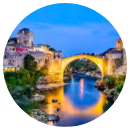
STEP BY STEP GUIDE TO BOSNIA
- Heritage Tours offers 2 tours a year accompanied with renowned Islamic Scholars which take place in April and September.
- To enter Bosnia & Herzegovina, a passport valid for six months beyond the date of arrival is required by and one blank page is needed for the visa.
- Member State of the European Union
- State signatory to the Schengen Agreement
- To apply or check status of your visa eligibility visit ivisa.com/bosnia-visa
- Hygiene in Bosnia & Herzegovina is some of the best standards in the world. The Bosnians are very conscious of cleanliness and purification.
- It is recommended to bring some motion sickness pills for the internal journeys.
- Hepatitis A / Measles
- The main international airport is in Sarajevo (SJJ).
- The national airline is Fly Bosnia Airways https://flybosnia.ba/ which offers direct flights from major destinations. There are also plenty of indirect fight options with carriers such as Emirates emirates.com , Turkish Airlines www.turkishairlines.com and a range of European airlines.
- Customs forms are required to be completed on arrival for you to declare any currency you are either bringing into, or taking out, along with the amount.
- There are no departure taxes.
- Bosnian Mark is the official currency but US dollars, Euros & GBP are also widely accepted and Bosnia is mainly a cash-based society.
- Credit cards MasterCard & Visa are accepted in major hotels and restaurants.
- ATMs can be found in all major locations.
- Currency exchanges are located around the main cities and a fee is charged for converting.
- Always take your passport with you as proof of ID when exchanging money.
- WIFI services are good offering reliable connectivity.
- Sim cards can be purchased at the airport on arrival or at phone shops and you will require your passport as proof of ID.
- Bosnian, Croatian and Serbian are the main languages spoken in, basic English is also understood at most tourist attractions.
- The three major religions of Bosnia are Roman Catholicism, Serbian Orthodox, and Islam. Bosnian Croats make up the majority of Roman Catholics. Bosnian Serbs make up the majority of the Serbian Orthodox population.
- Bosnian Muslims make up 45% the population, 36% Orthodox, 15% Roman Catholic, 4% Protestant, Jews and other denominations.
- Bosnia and Herzegovina is characterised by its ethnic and religious diversity and visitors should respect the customs and traditions of the various ethnic and religious groups.
- The main ethnic groups are the Bosniaks (48%, also sometimes referred to as Bosnian Muslims), the Serbs (37.1%) and the Croats (14.3%).
- Visitors should be aware that drinking alcohol in public is considered offensive.
- Dominated by mountainous and hilly terrain, and drained by major rivers to the north (Sava) and east (Drina), Bosnia and Herzegovina has a climate that is variable with moderate continental climatic conditions generally the norm (very cold winters and hot summers).
- The best time to visit is during the spring and autumn, with April and September being the absolute optimum month.
- In the winter it can be bitterly cold so bring layers.
- In the summer, it gets very hot so loose, breathable cottons are best.
- Crime level in Bosnia and Herzegovina is generally low.
- Beggars can be seen around the main cities and also be aware of pickpockets.
- Sarajevo is the capital of Bosnia & Herzegovina which sits on the Miljacka River, surrounded by the Dinaric Alps. Its home to landmarks of the old quarter, including Baščaršija, the Ottoman-era Gazi Husrev-bey Mosque and Latin Bridge the site of the 1914 assassination of Archduke Franz Ferdinand, an event that sparked World War I.
- Gazi Husrev-beg Mosque – In Sarajevo’s old town was built in 1532 and is the largest historical mosque in the country, and is the centre of the city’s Islamic community. It is exemplary of the Ottoman architecture for which the city is well-known, and is open for tourists to look around.
- Latin Bridge – One of the most well-known events that took place in Sarajevo was the assassination of Archduke Franz Ferdinand, the event that sparked the outbreak of the First World War.
- Tunnel Museum – An integral part to the survival of the Bosniak residents of Sarajevo during the civil war was the Sarajevo Tunnel , which acted as a lifeline to get food, aid, resources, weapons and often people in and out of the city while it was under siege. It was constructed in May 1992 by the Bosnian army, while all routes in and out of the city were blocked of by attacking Serb forces, in order to link up with the UN-controlled area on the other side of the Serbs.
- Sarajevo Town Hall – Easily one of the most stunning examples of architecture from the Austro-Hungarian Empire in Sarajevo is the town hall. Known locally at the Vjećnica , it was built in 1898 but underwent much recent refurbishment as it was a target for the Serbs during the war.
- Baščaršija – Sarajevo’s Old Town is the most historic part of the city, featuring architecture dating from the 15th century. Just as it was in the 15th century, the area is a market and bazaar and today is the cultural centre of the city. Full of narrow cobbled streets, the shops are small and full of character – a mix between Eastern European and Turkish influence. One of its focal points is the main square with its iconic fountain at the centre, if visitors can make it through the hundreds of pigeons to get there. It is home to a great range of traditional restaurants, cafés and coffee houses, so a perfect area to stroll around and explore.
- Mostar is a city straddling the Neretva River. It’s known for the iconic Stari Most (Old Mostar Bridge), a reconstructed medieval arched bridge and a landmark of the recent Bosnian war. The nearby alleys are full of market stalls and a narrow staircase leads up to the Koski Mehmed-Pasha Mosque’s minaret for panoramic city views.
- Stari Most – One of Mostar’s and also Bosnia’s most famous sites is the Stari Most, or ‘Old Bridge’. The bridge was built by the Ottomans in the 16th century and is exemplary of typical Islamic architecture and fine engineering. It crosses over the beautiful turquoise Neretva river, and is at the heart of Mostar’s historic Old Town.
- Blagaj Monastery – A short drive south of Mostar is the small village of Blagaj. Within Blagaj is the famous tekija , or monastery, which was founded by Dervish monks in the 16th century. The monastery is nestled at the foot of a cliff face, looking over a beautiful pool, and exemplifies classic Ottoman architecture, with its wooden window frames and overhanging roof.
- Čaršija – In the heart of Mostar’s picturesque Old Town is its market, or čaršija . There is a market on each side of the river near to the Stari Most, due to the split between the Bosniak and Croat ethnic groups that inhabit the city, although the difference between the two is not noticeable to visiting tourists. The market has a distinctly eastern feel, thanks to the historic Ottoman influences, with stalls selling rugs, painted plates, copper items, and souvenirs.
- Kravice Falls – A short drive south of Mostar are the Kravice Falls, some amazing waterfalls near the small town of Kravice. The falls are currently not a well-known attraction amongst tourists, meaning they are peaceful and not yet highly commercialised, although there is a small but useful boardwalk taking visitors closer to the falls.
- Koski Mehmed Paša Mosque – This stunning mosque is not only an attraction itself, but is also a spot for some of the best views of the Stari Most. The mosque was built in the early 1600s by the Ottomans, and today it is one of the best preserved mosques in the area. There is a small entrance fee that includes the climb up the minaret for 360º views of the bridge, and a stroll around the outside courtyard which also offers amazing views.
- War Photo Exhibition – Inside one of Mostar’s historic buildings is a photo gallery, featuring shots taken in Mostar by a New Zealand photographer during the civil war. It is located right next to the Stari Most, and is housed in a traditional dwelling which matches the personal stories of Mostar locals told through the photos.
- Srebrenica is a small town with a population of 2,604 inhabitants located in the eastern most part of Bosnia & Herzegovina and is still remembered for the Srebrenica massacre, also known as the Srebrenica genocide. In July 1995 genocide of more than 8,000 Bosniaks, mainly Muslim men and boys took place.
- Travnik became the capital of the Ottoman province of Bosnia and residence of the Bosnian viziers. The city became an important centre of government in the whole Western frontier of the empire, and consulates were established by various governments and today is the administrative centre.
- Stari Grad (Old Town) – A city’s heart and soul usually lies in the historical districts where streets and buildings resist change. Travnik’s Stari Grad has an Ottoman centre with mosques, centuries-old buildings, and Bosnia’s only sundial. Walking through gives a sense of what life is like in the 18th century when Ottoman governors used the area as their official seat of government.
- Travnik Castle – Dates back to pre-Ottoman Bosnia when the former Christian Kingdom ruled the region. The conquering Ottomans later developed and expanded the 14th- or 15th-century castle, transforming it into a fortress with watchtowers. Today, the castle is the best preserved in Bosnia and a national monument, making it a must-do in Travnik for all tourists.
- Jeni Mosque – About one kilometre to the west of Travnik Castle is Travnik’s oldest mosque. Jeni Mosque, completed in 1549 in a classical Ottoman style, predates the official Ottoman Vizier’s seat by more than a century. Every early settlement had at least one central mosque, and Jeni was Travnik’s. Throughout the almost 500-year lifespan, it has been destroyed and rebuilt several times. If you want to appreciate the rich history of the town, Jeni Mosque rates as one of the best things to see in Travnik.
- Sulejmanija Mosque – Colourful murals cover the Many-Coloured Mosque or Ornamented Mosque’s exterior, making it one of the more intriguing Travnik attractions. Built in the 16th century, the colour has since faded. Today, the mosque has three horizontal stripes. Tall arches form the lower and colourful murals decorate the top with a white-washed middle.
- By Train – There are multiple daily trains connecting Samarkand,
- By Rail – The national railway network between the major cities is well connected allowing you view the beauty of the country.
- By Road – Travel by road is the usual means of transport in Bosnia and Herzegovina. During winter and spring, block ice and landslides can make driving difficult.
- By Taxi – There are plenty of reliable taxi services and always use the meter and agree the price before accepting the ride.
- There are a range of hotels to cosy boutique hotels that you can experience across the country.
- Tap water is of good quality and safe to drink.
- Local meat, poultry, seafood, fruit and vegetables are generally considered safe to eat, although it is advisable to peel vegetables and fruit and only eat cooked meat and fish.
- Vegetarian options are available but limited in selection.
- Saudi Arabia
- Privacy Policy
- Terms & Conditions
© 2024 Heritage Tours
Do you want to open this link in the HalalTrip Mobile App?

- Halal Restaurants Near Me
- Halal Dishes Near Me
- Mosque Near Me
- Airports Near Me
- Attractions Near Me
- Home Based Businesses Near Me
- Where to Travel in 2024
- Halal Travel Blog
- Halal Travel Podcast
- City Guides
- Featured Destinations
- Destination Marketing
- Halal Travel Guides
- Travel Videos
- Explore Uzbekistan
- Explore Brunei
- Explore Indonesia
- HalalTrip Gastronomy Awards
- Mastercard Benefits Program
- Halal Holiday Packages
- Halal Friendly Hotels & Serviced Apartments
- Cruise Ship
- Qibla Direction
- Prayer times for flights
- Local Prayer Times
- Travel Etiquettes
- Foodie Awards
- Halal Travel Mobile App
- Ramadan 2024
- Productive Muslim Retreat
- HalalTrip 40
- Advertise With Us
- Human & Travelers Stories
- Muslim-Travelers Guide to Bosnia & Herzegovina
Muslim-Travelers Guide to Bosnia & Herzegovina

A Brief Of History Bosnia & Herzegovina
Getting around bosnia & herzegovina, the top attractions and best places to visit.

Image Credit: ADEV on Unsplash

Image Credit: Mujo Hasanovic on Unsplash
Sutjeska National Park

Halal Foods in Bosnia & Herzegovina
Mosques and prayer facilities, traveler precautions.
A content/creative writer who enjoys the world of writing, and an avid reader with many interests.
Leave a comment
Likes ×.
SPAIN BARAKA TOURS on Facebook
View on facebook!
LANGUAGE العربية
Select language.
ARABIC العربية
[email protected] | WhatsApp +34667959331 | Hotline 24h
Languages العربية | register | log in.

- Catalonia – Gate To Europe
- 7D6N Islamic Spain Heritage
8D7N Spain&Barcelona GIT
- 8D7N Golden Spain&Portugal
- 9D8N Beauty Of Morocco
- 12D11N Spain&Morocco Deluxe
- See all Muslim Packages
- Guaranteed Departures (SIC)
- Tailor-Made Tours
- Discover Barcelona!
- Discover Madrid!
- Free & Easy – Excursions
- Muslim Honeymoons
- Real Madrid Campus Experience
- Women Group Tours
- Family Trips
- Shopping Trips
- Soccer Matches & Sports Events

Ref. BK-G08ZAMI01 Muslim Package
09 Days - 08 Nights Full Board
All Inclusive
Transportation - Sightseeing - Guiding
Essence of European Muslim Cities!
Zagreb - Bihac - Jajce - Sarajevo - Mostar - Split - Ancona - Bologna - Venice - Milan
MUSLIM PACKAGE HALAL TOUR DETAILS
Day 1 - arrival zagreb (croatia) - bihac (bosnia).
Meet and greet at Zagreb Intl. Airport by our local representative and coach transfer. Halal lunch .
Start our road trip with destination to the city of Bihac , Bosnia. Prayers at Fethija Mosque.
Halal dinner , transfer and check-in at hotel. Overnight in Bihac.
DAY 2 - BIHAC - JAJCE - SARAJEVO
Breakfast. After hotel check out, we will proceed to Jajce . Start the City Sightseeing Tour of its Old Town and shopping at Jajce Bazaar. The panoramic tour includes the Fortification System, Buric’s house, Women’s Mosque, Esmo Sultanija Mosque, Royal Grave, Jajce and its Ancient District, Musafirhana, Necropolis with Stecci in Vinac, Omer-bey’s House, Watermills Complex on Pliva Lakes and the Fortress of Jajce. In year 2006 Jajce was nominated as a UNESCO heritage site. Halal lunch.
Proceed to Travinik Town, prayers in Travinik’s Mosque and visiting the Madrasse.
In the afternoon we continue on travel to Visoko Town, and visit the Bosnian Pyramid, Visocica Hill – the 1 st European pyramid to be discovered and located in the heart of Bosnia. The pyramid has 4 perfectly shaped slopes pointing towards the cardinal points. On top of the pyramid we find also the ruins of a Medieval walled town, the anciente base of the Bosnian King Turtko of Kotromanic (1338 – 1391). Proceed our trip to Sarajevo city.
Halal dinner , hotel check in and overnight in Sarajevo.
DAY 3 - SARAJEVO
Breakfast. Embark on the City Tour. Sarajevo is one of the most Oriental and culturally diverse cities in Europe. It has been for over 300 years under Turkish rule, until the Austro-Hungarians arrived in the late nineteenth century. The Empire collapsed 50 years later, when Archduke Ferdinand was murdered here, hastening the outbreak of the World War 1st. The late twentieth century saw Sarajevo hosting the Winter Olympics in 1984, and the long siege of the city during the recent conflict. Halal lunch .
After prayers, proceed the tour visiting the Old Town: the War Tunnel, River Spring Bosnia, Begova Mosque, Husrey Bey Medresse, Brusa Bezistan (Old Bazaar), and the Old Coppersmiths at work, between others.
Halal dinner with a cultural performance and overnight in Sarajevo.
DAY 4 - SARAJEVO - MOSTAR
Breakfast. Hotel check out and proceed enjoying our travel with destination to Jablanica . Halal lunch .
Proceed to the city of Mostar. Embark on a Walking Tour of the Old Town. Our guided city tour will include visits to Public Turkish Bath (Hammam), Clock Tower, Karadjoz-Beg Mosque, Old Bridge, Prayer at Mehmet Pasa Mosque. After, enjoy shopping time in Mostar.
Proceed to Blagaj Village. Visit the Buna River Spring, Sufi Teke and time for prayers in Blagaj.
Halal Dinner , travel back to Mosta for check in and overnight in Mosta.
DAY 5 - MOSTAR - SPLIT - FERRY
Breakfast. Check out and travel to Split . Halal lunch.
Proceed with the panoramic City Tour, discovering the UNESCO listed Diocletian’s Palace, with its Peristile. The walking tour will feature the main highlights of the city, the Golden Gate, the City Clock and the City Hall Building. Visit of the Pazar, the open market. Halal dinner .
After, we will reach the Port to board the Ferry, departing with destination Ancona .
Overnight onboard.
DAY 6 - ANCONA - BOLOGNA - VENICE
Breakfast on board. Arrival to Ancona Port , transfer to our coach and travel to Bologna.
Upon arrival, we will take the Bologna City Sightseeing Tour. Proceed our trip to Venice . Halal lunch .
In the afternoon, hotel check in and leisure time to explore and discover the lovely Venice’s corners.
Halal dinner and overnight in Venice.
DAY 7 - VENICE - MILAN
Breakfast. After hotel check out we will enjoy the Venice City Sightseeing Tour. Embark on the iconic Gondola Trip , along Venice’s Canals. Visit the highlights of Venice, including time for shopping at Piazza San Marco, San Polo, Campo Santo Stefano, Rialto District, Lodo Gran Viale. Halal lunch .
After some more shopping time, proceed our trip to Milano .
Halal dinner , hotel check in and overnight in Milano.
DAY 8 - MILAN
Breakfast. Embark on the Bus City Tour. Visiting Vittorio Emmanuele II and Porta Sempione. Halal lunch .
After prayers, proceed exploring the Shopping areas. Discover Milano’s Quadrilatero della Moda, the city’s glitzy fashion district. So called Milan’s Fashion Quadrangle, the glamorous neighborhood is home to a litany of the world’s leading fashion designers, who have spread their shops over famous streets like Via Montenapoleone, and other areas like Via Dante, Corso Vittorio, Buenos Aires.
Halal dinner and overnight in Milan.
DAY 9 - MILAN - DEPARTURE
Breakfast. After hotel check out, we will have free leisure time to enjoy the corners of Milan. Halal lunch .
After prayers, proceed to Malpensa Intl. Airport for departure with warm memories.
Request Your Price!
We spent a very nice and friendly time, just relax and enjoy..!
Mrs. Aminah Bte. Kamaruddin
We were amazed of Scandinavia, the snow and its mosques!
PRICE INCLUDES
Transfers in-out yes, meet & greet yes, program on halal full board according itinerary yes, entrance fees according program yes, modern transportation scandinavia yes, ferry tickets yes, official local guides yes, muslim engligh speaking escort guide yes, 1 litter of water for each 4 pax during meals yes, 1 bottle of water 330ml daily during the tour yes, price excludes, other services or extras not, insurance not, beverages during meals – lunch or dinner not, porters at the airport or hotels not, tipping not, luggage services not, check some views, tour gallery.

REQUEST PACKAGE
Customer care, +34 934 742 300, 24h attendance, +34 667 959 331, you may also like.
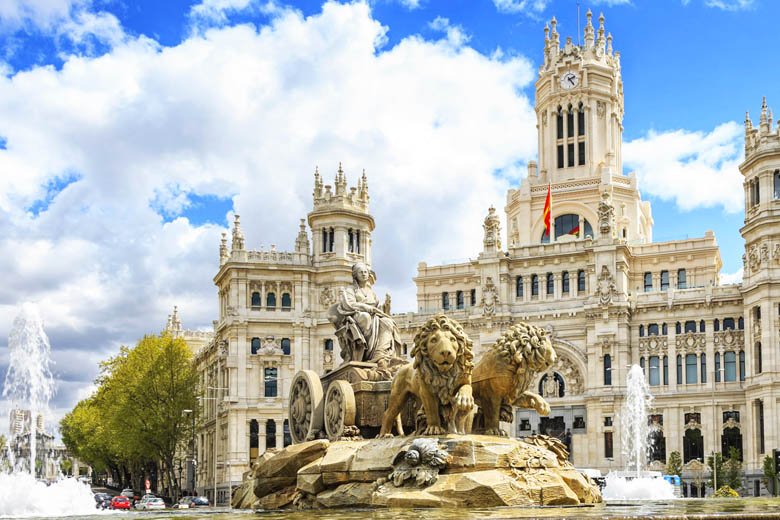
Discover MADRID
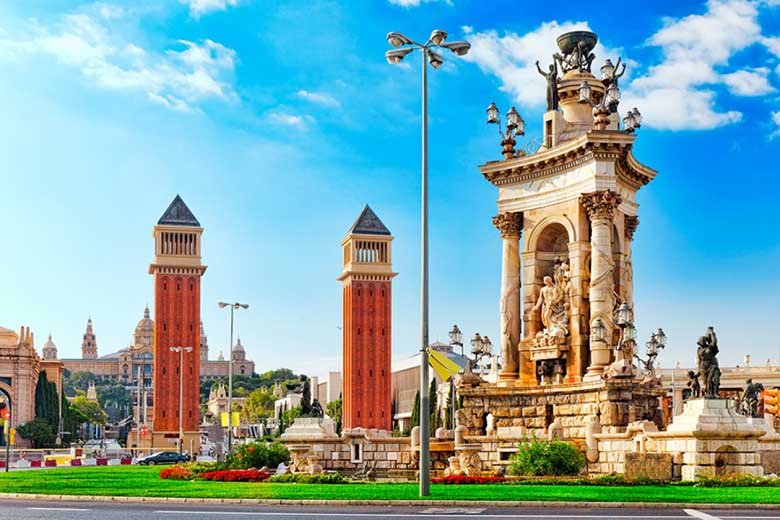
11D10N Scandinavia Special
Spain baraka tours halal tours®.
Tirso de Molina, 36 08940 BARCELONA
Mobile: +34667959331
Mail: [email protected]
Follow us on Facebook!
Contact us.
© Copyright 2008-2023 SPAIN BARAKA TOURS HALAL TOURS®
This survivor’s deeply personal tour of Sarajevo is the best way to understand Bosnia’s past

Jun 9, 2023 • 5 min read
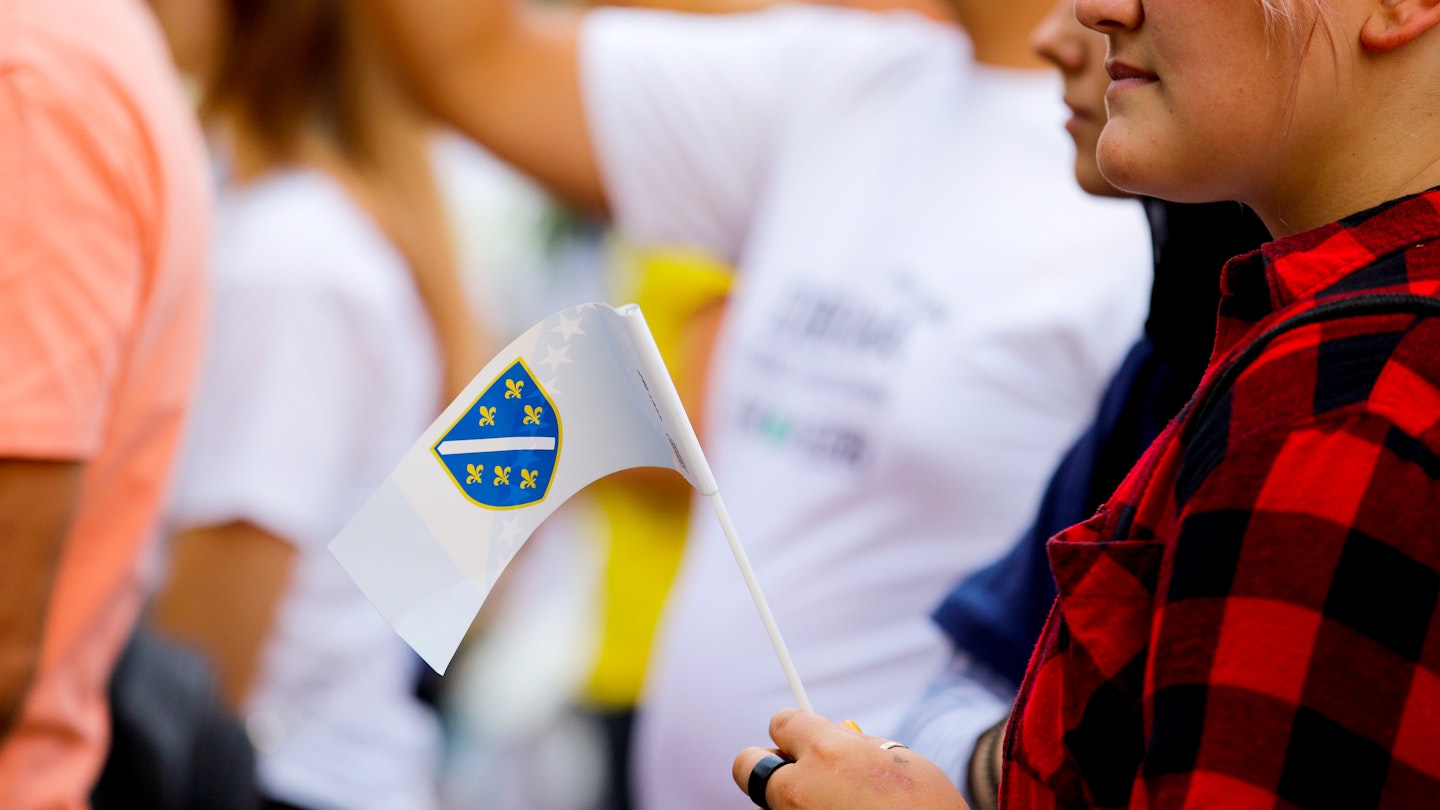
A tour of Sarajevo offers a chance to learn more about Bosnia's difficult past. © Getty Images
Lonely Planet’s People You Meet series profiles people we think you should meet on your journey – those who make lasting impressions and help you connect more deeply with the destination.
“How do you like my artwork?” says Almir Ahmetagic, a wry smile creeping across his face as he points to a large dent in the minivan we have just clambered out of. He shrugs and lets out a small laugh, his car keys jangling in his hand.
It instantly breaks the ice among our intimate three-person tour group. Thirty years on from the end of the Bosnian War, we have just been taken to one of the many places where bullet holes still pepper Sarajevo ’s residential buildings.
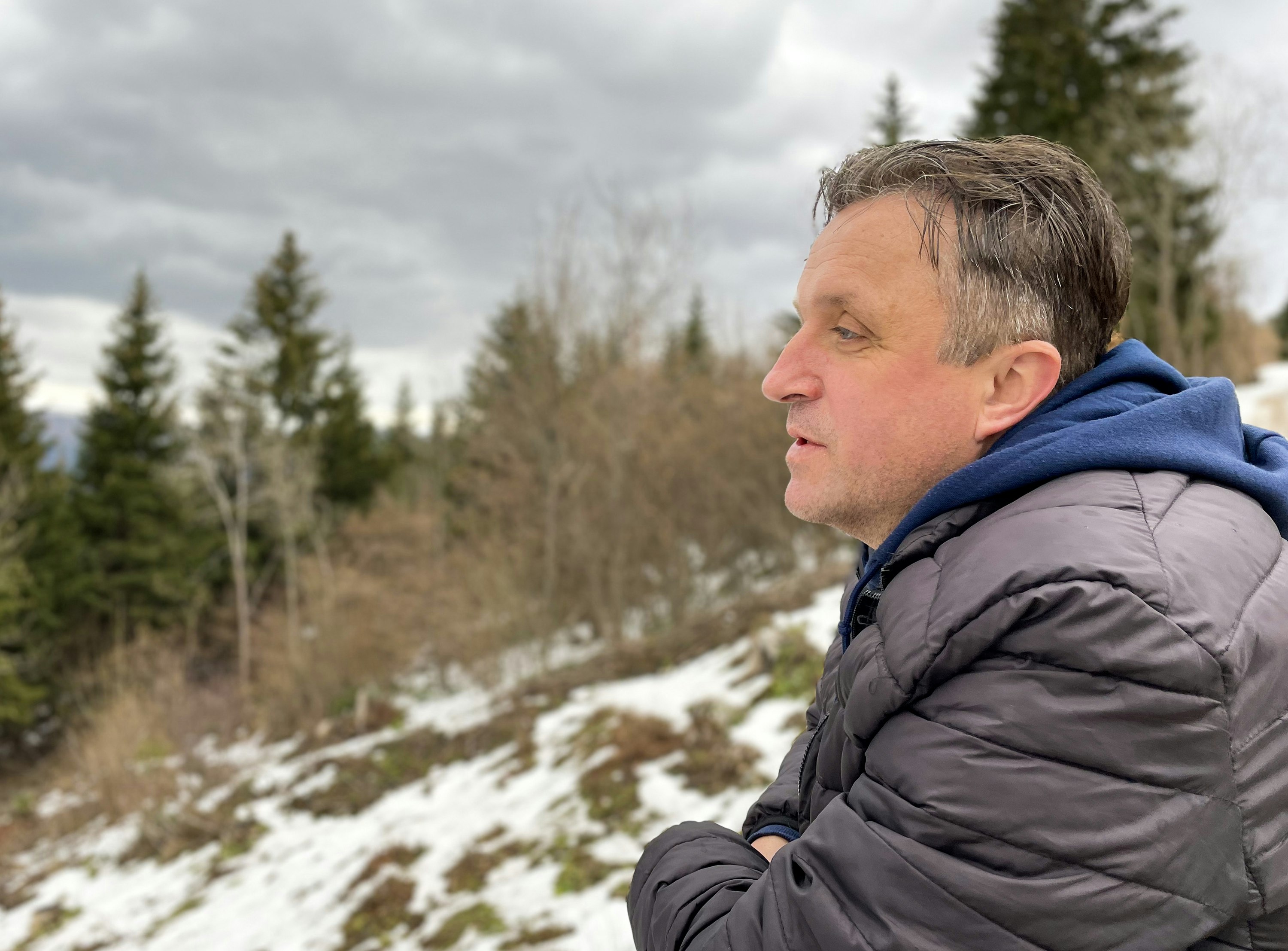
Sure, we’re learning about one of the most brutal and longest sieges in modern history – but with Almir around, we can expect a few dark-humored jokes along the way.
His experience of surviving the war is harrowing. He was shot twice and had to watch as enemy forces burned down his home, not long before his own brother tragically died from sniper fire.
But despite all this, his story – and that of the city – is leavened with hope.

Almir’s hope-filled tour of Bosnia’s difficult past
He was about 15 when the siege of Sarajevo began in 1992, and joined the army that year with his brother to fight against the Serbian forces that had besieged the capital city.
Witnessing firsthand many of the pivotal moments from the near-four-year-long siege, Almir today provides guided tours of his hometown for visitors who want to better understand Bosnia and Hercegovina ’s difficult but fascinating past.

“I was thinking, ‘I’m going to impress all these girls,’” he tells us, jokingly recalling why he joined the army. “But, really, the Serb army left us only one option: to fight. Because in every town that was taken, civilians were killed.” It’s estimated that around 100,000 people died during the war, while more than two million were displaced.
He ushers us over on foot to the first major stop of the tour, Sarajevo’s Tunnel Museum . It’s a small, crumbly, bullet-strewn building that looks no different than many of the houses nearby.
On the floor near the entrance are traces of what looks like faded red paint. Yet we soon learn of their significance: this is a Sarajevo Rose, one of around 200 memorials you can find across the city that have been made from concrete scars caused by mortar shell explosions and later filed with red resin.

It may be called a rose, but it looks more like blood – and is pretty chilling. It brings home the brutality of war. These are spots where people more often than not lost their lives.
Almir explains how Serb forces – who had wanted to create a new Bosnian Serb state after Bosnia and Hercegovina declared independence during the breakup of Yugoslavia – had encircled Sarajevo, cutting off residents’ electricity, water and food.
Multiethnic Bosnia is mainly made up of Muslim Bosniaks, Orthodox Serbs and Catholic Croats; during the war, it was the Bosniak population that fell victim to what is widely today considered ethnic cleansing by the Serb forces. Sarajevo today remains a majority Bosnian Muslim population, with residents like Almir identifying as Bosniak.

Sarajevo occupies the bowl of a valley, and snipers positioned themselves advantageously in the surrounding mountains, regularly opening fire on soldiers and civilians, says Almir. “The first time I was wounded was by a small piece of shrapnel. That piece of shrapnel is still in my head,” he adds, tapping his skull.
The second time he was not so lucky, with shrapnel hitting his spine. “I was told I would never walk again,” says Almir, who spent a shocking three years in the hospital recovering from the wound. Fortunately, he proved the doctors wrong and can walk today.
To survive and communicate with the outside world, the Bosnian army and volunteers dug a tunnel to an area outside Sarajevo that was free-Bosnian territory. This meant food, war supplies and humanitarian air could enter the city – and is how the “Tunnel of Hope” came to be named.

Armed with this knowledge, we head 16ft (5m) underground to experience part of the tunnel for ourselves. The space tightens, the temperature drops. It’s awe-inspiring to think that the 2625ft (800m)-long tunnel was built in just over four months, during heavy bombing and artillery fire. “Mind your head,” warns Almir, who traveled the route multiple times. “I had to get stitches once!” We walk through, crouched over, with lamps overhead lighting our path.
Perspective from the Trebević Mountain
After emerging back at the surface, we hop back into the minivan to journey up the beautiful Trebević Mountain, which overlooks Sarajevo. En route, Almir points to popular restaurants, cafes and hangouts as we drive through what is today very much a thriving and bustling city.
High up, Almir shows us where the snipers had once dug in. No one’s around as we stand on the mountain ridge and quietly survey the city in peace. At the time of our visit, a thick blanket of snow covers the ground. I imagine how perfect this spot would be to take refuge from the summer heat.
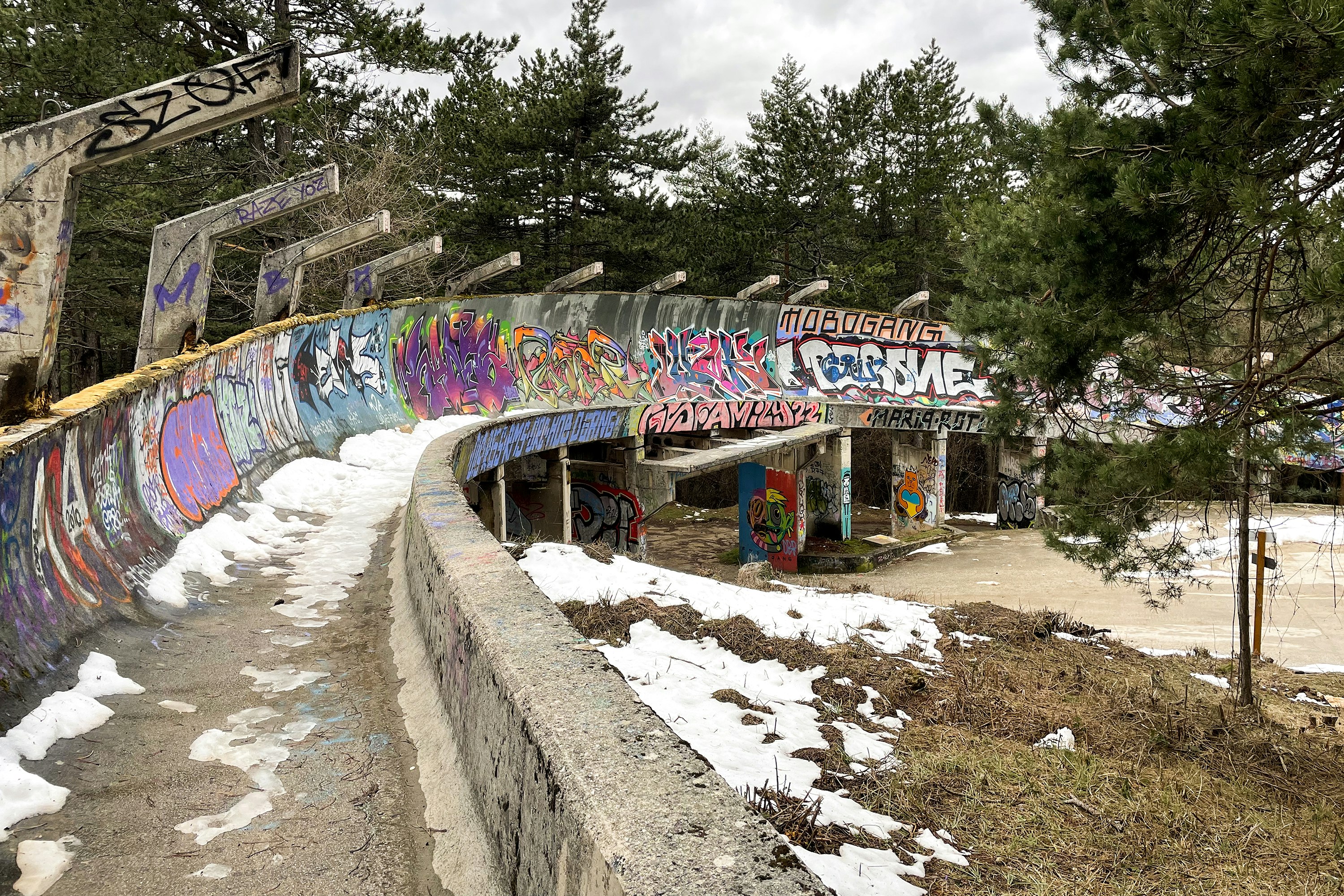
Before we travel back down to the city, we visit the mountain’s abandoned Olympic bobsled track, from the 1984 winter games. Surrounded by a protected forest with a number of hiking routes, we walk along the bobsled course, which is covered in graffiti and flecked with holes made by mortar shells and artillery damage.
Our final stop is at one of the largest and oldest Jewish cemeteries in Europe, which was located on the frontline during the war and is also sadly scarred by shelling. We’re told how the Serb forces used it as an artillery position, and how a number of the graves still remain flattened after collapsing from the heavy weaponry propped up on them.
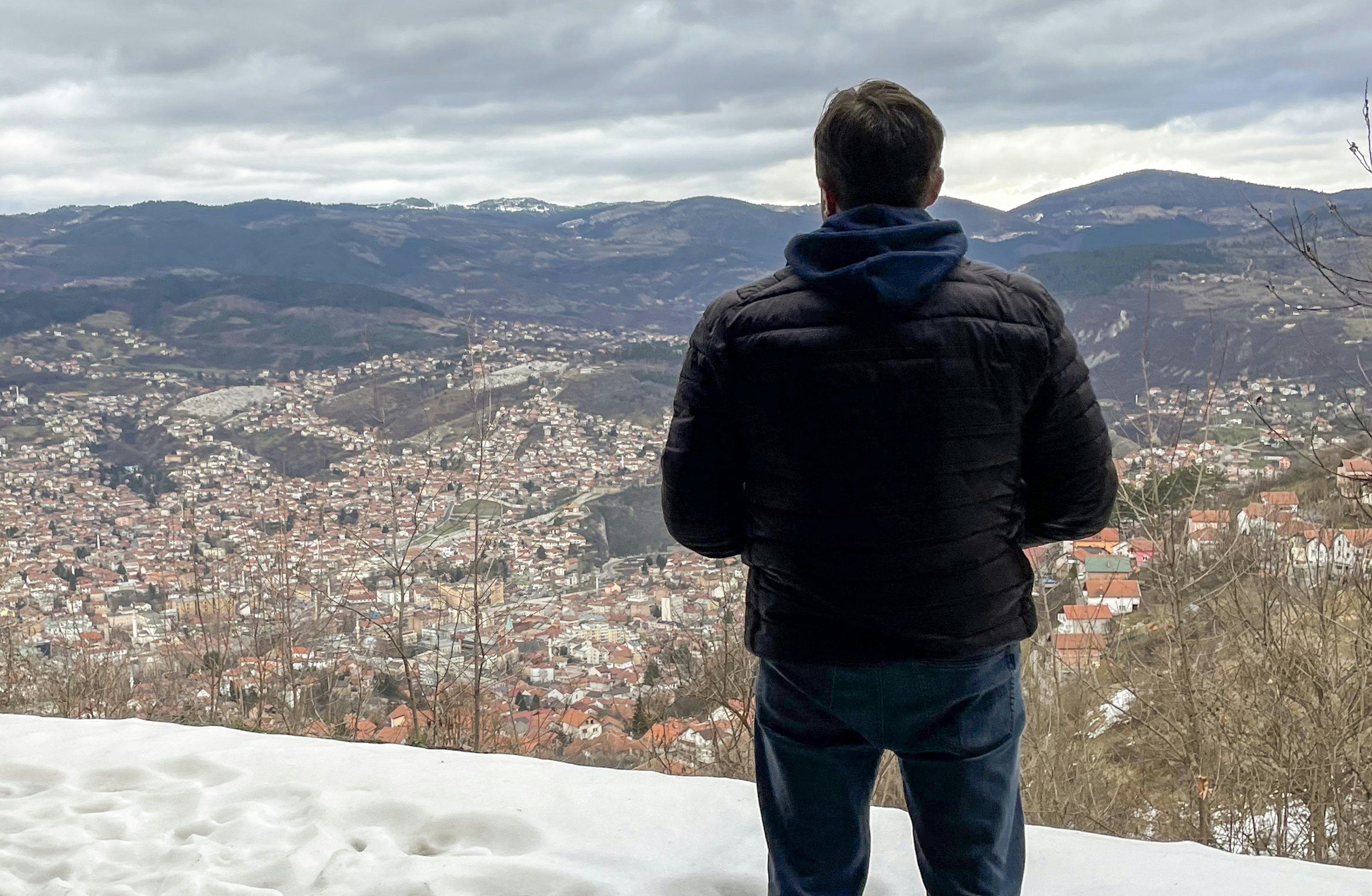
Yet like many of the other stops on the tour, there’s a quiet peace now on the grounds, despite all the site has witnessed. That same sense of calmness comes through in the capital’s residents, too. Such as Almir, who – more than anything else – is a champion of his hometown. And of hope.
How to book
Almir’s half-day Sarajevo siege tour can be booked online via Funky Tours. Tickets cost around €30 per person, and include entry to the Tunnel Museum.
Explore related stories
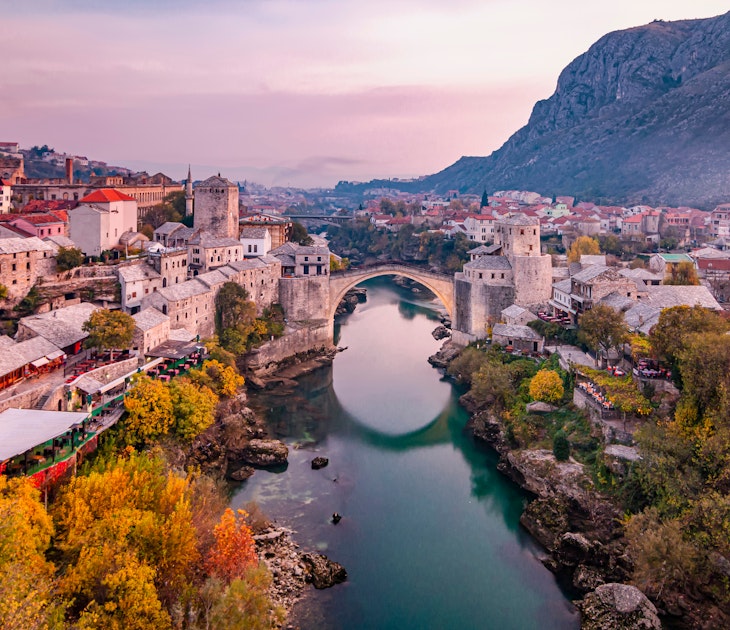
Water Sports
Oct 2, 2023 • 5 min read
The Stari Most is one of the most iconic monuments in the Balkans. But what’s it like to dive off of it?
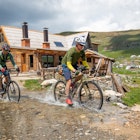
Sep 25, 2023 • 4 min read
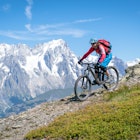
Apr 11, 2023 • 4 min read
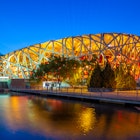
Jul 22, 2021 • 3 min read
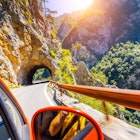
Feb 1, 2021 • 5 min read
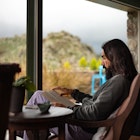
Mar 27, 2020 • 12 min read

Feb 10, 2020 • 2 min read
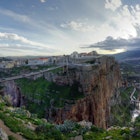
Jan 6, 2020 • 2 min read
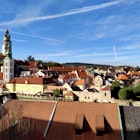
Nov 27, 2019 • 5 min read
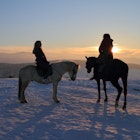
Oct 18, 2019 • 5 min read

21-Day Balkan Tour Itineraries
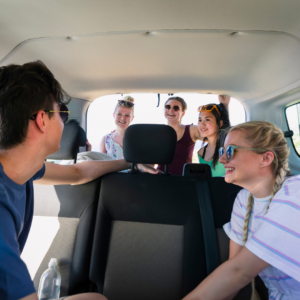
Explore the well-known as well as the hidden parts of the Balkans with a highly experienced, fully licensed guide who can offer insights as well as helping you talking with local people.
You can personalize your tour to s tart, stop and finish in any country of the region. Take the opportunity to include active adventures or days “off” where you explore a little on your own.
We’ll help you create your dream Balkan tour itinerary.
What your tour includes
- Insights – your friendly, fully licensed guide will be there to help you experience the true Balkans. In conversation, translating and guiding you through the stunning landscape and history.
- A personal experience – you decide where we’ll stop and start on your tour. We will customize your trip so that it includes all of your must-sees and must-dos.
- A free, no-obligation quote – including all fuel, taxes, parking fees – everything required to make your trip happen will be included in your upfront quote.
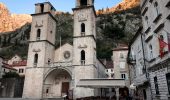
What sights have you got on your “non-negotiable” list?
Where would you like to start your tour?
Shall we drop you off at the airport afterwards?
Take a look at some of our most popular tour itineraries here…
21 Days / 10 Countries Tour
GREECE – NORTH MACEDONIA – KOSOVO – ALBANIA – MONTENEGRO – CROATIA – BOSNIA AND HERZEGOVINA – SLOVENIA – SERBIA – BULGARIA
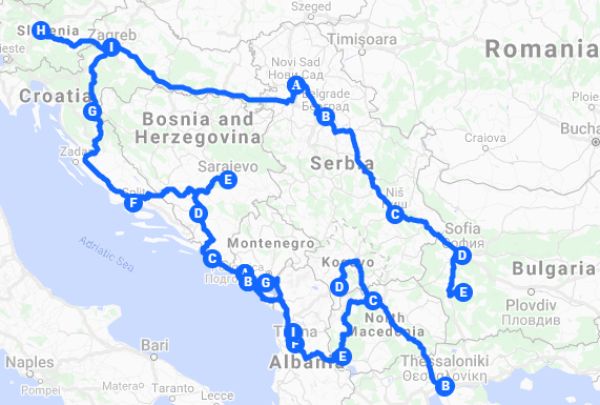
Detailed itinerary
Day 1 arrive in thessaloniki, greece.
Start the 21 days Balkan tour with a pick up from Thessaloniki airport.
→ Airport transfer to your hotel in Thessaloniki
→ Free time to relax and refresh
Overnight in Thessaloniki
Day 2 – Thessaloniki, Greece
Spend the day in Thessaloniki, Greece
→ Walking city tour of Thessaloniki in the morning City tour of the city Visit the White Tower, Arch of Galerius and Rotunda, Hagia Sophia, Thessaloniki, Aristotelous Square, the Church of Panagia Chalkeon
→ Free time in the afternoon
Day 3 – Meteora, Greece
→ Transfer to Meteora area Explore the Meteora rock monasteries
→ Transfer back to Thessaloniki
Day 4 – Skopje, North Macedonia
→ Transfer to Skopje, North Macedonia
→ Skopje walking tour Visit the most interesting sights in Skopje. Visit the Old muslim quarter, the Stone bridge, the Macedonia square, the Memorial house of Mother Teresa, the “Warrior on a horse” monument, the “Mustafa Pasha” mosque, the Skopje art bridge, the “Daut Pasha” Hamam, the “Mothers of Macedonia” fontain, The Divers statue, Kapan Han, the King Samuil monument, the Archeological museum building.
→ Free time in Skopje
Overnight in Skopje
Day 5 – Prizren, Kosovo
→ Depart from Skopje after breakfast
→ Transfer to Prizren, Kosovo via the mountain road
→ Walking tour Prizren Visit the city center; Our Lady of Ljeviš Church (14th-century Serbian Orthodox church); Sinan Pasha Mosque (17th Century mosque)
→ Transfer back to Skopje
Day 6 – Ohrid, North Macedonia
→ Transfer to Ohrid, North Macedonia
→ Walking Ohrid City tour Visit the Ohrid lake, the Monument of St. Naum of Ohrid, the Monument of St Kliment Ohridski, Catcher of a cross monument, the Church of St Sofia, “St Kiril and Metodius” monument, the Ancient theatre of Ohrid; the St John at Kaneo church.
→ Free time in Ohrid
Overnight in Ohrid
Day 7 – Tirana, Albania
→ Transfer to the St. Naum Monastery, North Macedonia
→ Explore the monastery complex
→ Transfer to Tirana, Albania Visit the “Skanderberg square”, the “Ethem bey” mosque, the “Enver Hoxha” pyramid, the Peace bell, the Polytechnic University of Tirana, the Building of the historical museum of Tirana, a Preserved bunker, Maria Theresa boulevard, the University of Tirana, the Old government square.
Overnight in Tirana
Day 8 – Kruje, Albania – Skadar Lake, Montenegro
→ Transfer to Kruje, Albania
→ Explore the Birthplace of Skanderberg Visit the fortress and the old part of town
→ Transfer to Skadar lake (The biggest lake on Balkans) Boat trip to explore the lake
→ Transfer to Budva, Montenegro
→ Free time in Budva, Montenegro
Overnight in Budva
Day 9 – Kotor, Montenegro
→ Day tour to Kotor Bay and the old town of Kotor.
→ City tour and free time Visit the Kotor old city, Kotor harbour, city walls, St Tryphon cathedral, St Nicola church, Piaza of the arms, Church of St Luke, Gurdich gate, Clock tower, Grubonja palace, Karampana well, Drago palace, Pima palace, Beskuca’s Palace, Grgurina Palace, Bizanti Palace, Prince’s Palace, Sea gate, Old Kotor prison building
→ Transfer back to Budva
Day 10 – Dubrovnik, Croatia
→ Transfer to Dubrovnik, Croatia
→ Dubrovnik old town city tour Visit the Old town, the Ancient city walls, the Dubrovnik “Saint Saviour” church (16th century church with Renaissance architecture); the Dubrovnik cathedral (Early 18th-century baroque cathedral); The Onofrije’s fountain, The Franciscan Monastery (Landmark monastery built in the 1300s, noted for its cloister, library & historic pharmacy displays); the Gates of Pile; the Old port; the Clock tower, the Sponza Palace, the Rector’s Palace; the Fort Saint John; the Stradun (The main walking street in Dubrovnik old town);
→ Free time in Dubrovnik
Overnight in Dubrovnik
Day 11 – Mostar, Bosnia and Herzegovina
→ Transfer to Mostar, Bosnia and Herzegovina
→ Walking tour of Mostar old town Visit the Old bridge, The Old city, The Old turkish bazar “Kujundziluk”, The Old turkish quarter, “Koskin – Mehmed pasha’s” mosque, Tito’s palace, “Mehmed Karadoz” Mosque.
→ Transfer to Blagaj Visit the Blagaj monastery
→ Transfer to Sarajevo via Konjic
Overnight in Sarajevo
Day 12 – Sarajevo, Bosnia and Herzegovina
→ Transfer to Sarajevo, Bosnia and Herzegovina
→ Private tour Sarajevo Visit the Bascarsija (The historical Turkish market); Gazi Husrev-beg Mosque (Ottoman mosque from 16th century); The Latin Bridge/ The Assassination Bridge (Ottoman-era stone bridge near the site of Archduke Franz Ferdinand’s 1914 assassination); The Sebilj Monument (Famous 18th century wooden fountain); the “Sacred Heart” Cathedral (Gothic cathedral from the 19th century); The Sarajevo city hall, The Abandoned Bobsleigh Track (Built in 1984 for the Winter Olympic games in Former Yugoslavia The country opened its doors to the international community to celebrate sport, after the breakup of Yugoslavia, during the long Sarajevo siege the bobsleigh track been used as a base for the artillery); The Tunnel of Hope (Military-history museum at the site of a storied Bosnian War–era underground tunnel);
→ Free time in Sarajevo in the afternoon During your free time in Sarajevo you can enter the Museum of Sarajevo 1878–1918 (Compact museum dedicated to historical events in Sarajevo during the Austro-Hungarian period.); The War Childhood Museum (Prominent museum featuring exhibits & videos on the children who lived through the Bosnian War.); The Museum of Crimes Against Humanity and Genocide
Day 13 – Split, Croatia
→ Transfer to Split, Croatia
→ Split city tour Visit the old town, The Diocletian Palace; The Cathedral of Saint Domnius (Built in the 4th century AD); The Riva (The central part of Split); The Old Jupiter’s Temple (built in the 3rd century AD); The “Let me pass” street; The Golden Gate (4th-century Roman stone entryway to Diocletian’s Palace, with arches & ornate statues);
→ Free time in Split in the afternoon
Overnight in Split
Day 14 – Plitvice Lakes National Park, Croatia
→ Transfer to the Plitvice Lakes National Park Discover the number one nature sight in Croatia
→ Transfer to Ljubljana, Slovenia
Overnight in Ljubljana
Day 15 – Ljubljana, Slovenia
→ City tour in the morning Visit the The Dragon Bridge; Tromostovje (The Triple Bridge is a group of three bridges which connects the historical part of Ljubljana with the modern part of the city); Preseren Square (The central square in Ljubljana part of the old town’s pedestrian zone), Franciscan Church of the Annunciation (17th-century Franciscan church famous with its interior). Robba fountain (18th-century fountain made of limestone and marble); The Bucher’s bridge; The town square; Ljubljana Town Hall; The city market of Ljubljana; The Ljubljana cathedral (Roman Catholic cathedral with a baroque interior, including gilded columns & ceiling frescoes)
→ Transfer to Zagreb, Croatia after lunch
→ Free time in Zagreb
Overnight in Zagreb
Day 16 – Zagreb, Croatia
Spend the day in the Croatian capital – Zagreb
→ Walking city tour in the morning. Explore the Croatian capital. Visit the Museum of Broken Relationships, Old Town Gate, traditional Croatian pastry shop Vincek, Lenucijeva Potkova.
→ Free time in Zagreb in the afternoon
Day 17 – Novi Sad – Belgrade, Serbia
→ Transfer to Novi Sad, Serbia Visit the Petrovadian fortress and the old part of town
→ Transfer to Belgrade Free time in Belgrade
Overnight in Belgrade
Day 18 – Belgrade, Serbia
→ City tour of Belgrade in the morning Visit the Belgrade fortress “Kalemegdan” (Enduring fortress built in 535 BCE) with a view to Sava and Danube rivers; The Pobednik Monument (Monument inside the Belgrade fortress); Church of the Holy Mother of God / Crkva Ruzica (Serbian Orthodox church located inside the Belgrade fortress); The “Knez Mihaylova” pedestrian street; t. Sava cathedralS (The biggest Orthodox cathedral in the Balkans ); The Republic square, The National Assembly, The bombed buildings.
→ Free time in Belgrade During your free time you can take a walk around the Belgrade waterfront or enter some of the museums in Belgrade: Nikola Tesla Museum; The History museum of Serbia; etc.
Day 19 – Nis, Serbia
→ Transfer to Nis, Serbia Visit the Nis fortress; the Concentration camp “Red Cross” (The only preserved concentration camp from the Second War War on the Balkans); The skull tower; The Mediana (the birthplace of Constantin the greatest)
→ Transfer to Sofia, Bulgaria
→ Free time in Sofia
Overnight in Sofia, Bulgaria
Day 20 – Sofia and Rila Monastery, Bulgaria
→ Transfer to the Rila monastery Explore the monastery complex complex
→ Transfer back to Sofia
→ Free time for lunch in Sofia (optional)
→ Sofia city tour Visit the: St. Nedelya square; Nedelya church; St Sofia Monument; St. Petka Church; The old Serdika Ruins; The mineral springs; The council of ministers; The Rotunda “Saint George”; The Presidency; The mosque “Banya Bashi”; The National archaeology museum (not going inside); The National Bank of Bulgaria; Knyaz Alexander Battenberg Square; The King’s palace; The Russian church; St. Sofia Church; The National Theater; The Monument of the “unknown soldier”; The Alexander Nevski Memorial Church; The city garden.
Overnight in Sofia
Day 21 – Plovdiv, Bulgaria
→ Transfer to Plovdiv area, Bulgaria
→ Visit Bachkovo monastery
→ Plovdiv city tour Visit the Old town from the 19th century; the Ethnographic museum; Balabanov house; the Ancient theatre of Philippopolis; the Ancient stadium of Philipopolis, The St St Constantin and Elena church, The Djumaya mosque and square, The building of the Regional Historical Museum, the Main walking street, “The Trap” neighborhood; Nebet tepe.
→ Free time for lunch
End of the tour
21 Days / 9 Countries Itinerary
SLOVENIA – CROATIA – BOSNIA AND HERZEGOVINA – MONTENEGRO – ALBANIA – NORTH MACEDONIA – BULGARIA – ROMANIA – SERBIA
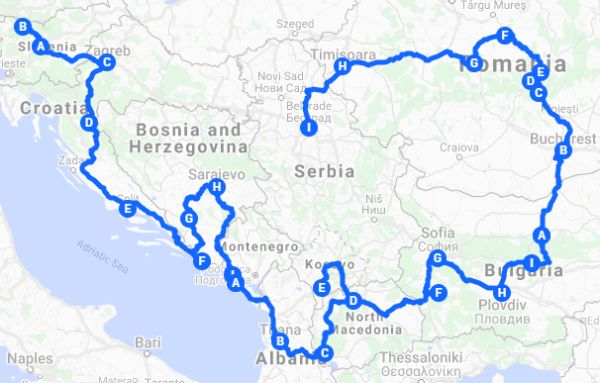
Day 1 – Ljubljana, Slovenia
The 3 weeks Balkan tour starts from any location in Ljubljana, Slovenia (airport or hotel)
→ City tour of Ljubljana, Slovenia The Dragon Bridge; Tromostovje (The Triple Bridge is a group of three bridges which connects the historical part of Ljubljana with the modern part of the city); Preseren Square (The central square in Ljubljana part of the old town’s pedestrian zone), Franciscan Church of the Annunciation (17th-century Franciscan church famous with its interior). Robba fountain (18th-century fountain made of limestone and marble); The Butcher’s bridge; The town square; Ljubljana Town Hall; The city market of Ljubljana; The Ljubljana cathedral (Roman Catholic cathedral with a baroque interior, including gilded columns & ceiling frescoes).
→ Visit Lake Bled in the afternoon
Overnight in Ljubljana.
Day 2 – Zagreb, Croatia
→ Transfer to Zagreb, Croatia
→ City tour and free time in Zagreb, Croatia Visit the Old Town; The Zagreb Cathedral; St. Mark’s church (Monumental, medieval-style, Serbian Orthodox church); Dolac Market (Large market with many stands offering flowers, fruits, veggies & meats in an indoor/outdoor setup); The Lotrscak Tower; The Medieval Stone Gate; The Lenucijeva Potkova. Ban Josip Jelačić Square (The central square of Zagreb)
Day 3 – Plitvice Lakes National Park, Croatia
→ Transfer to the Plitvice lakes National Park Explore the UNESCO protected national park
→ Transfer to Zadar, Croatia Free time in Zadar
Overnight in Zadar
Day 4 – Split, Croatia
→ Visit Sibenik and Trogir on the way
→ Split old town tour Visit the old town, The Diocletian Palace; The Cathedral of Saint Domnius (Built in 4th century AD); The Riva (The central part of Split); The Old Jupiter’s Temple (build in 3rd century AD); The “Let me pass” street; The Golden Gate (4th-century Roman stone entryway to Diocletian’s Palace, with arches & ornate statues);
→ Free time in Split
Day 5 – Dubrovnik, Croatia
→Free time in Dubrovnik in the afternoon
Day 6 – Mostar, Bosnia and Herzegovina
Day 7 – sarajevo, bosnia and herzegovina.
→ City tour of the old town in Sarajevo Visit the Bascarsija (The historical Turkish market); Gazi Husrev-beg Mosque (Ottoman mosque from 16th century); The Latin Bridge/ The Assassination Bridge (Ottoman-era stone bridge near the site of Archduke Franz Ferdinand’s 1914 assassination); The Sebilj Monument (Famous 18th century wooden fountain); the “Sacred Heart” Cathedral (Gothic cathedral from the 19th century); The Sarajevo city hall, The Abandoned Bobsleigh Track (Built in 1984 for the Winter Olympic games in Former Yugoslavia The country opened its doors to the international community to celebrate sport, after the breakup of Yugoslavia, during the long Sarajevo siege the bobsleigh track been used as a base for the artillery); The Tunnel of Hope (Military-history museum at the site of a storied Bosnian War–era underground tunnel);
Overnight in Sarajevo, Bosnia and Herzegovina
Day 8 – Kotor, Montenegro
→ Transfer to Kotor
→ Kotor old town tour Visit the Kotor old city, Kotor harbour, city walls, St Tryphon cathedral, St Nicola church, Piaza of the arms, Church of St Luke, Gurdich gate, Clock tower, Grubonja palace, Karampana well, Drago palace, Pima palace, Beskuca’s Palace, Grgurina Palace, Bizanti Palace, Prince’s Palace, Sea gate, Old Kotor prison building
→ Free time in Kotor for lunch (optional)
Day 9 – Tirana, Albania
→ Transfer to Tirana, Albania
→ Tirana walking tour Visit the “Skanderberg square”, the “Ethem bey” mosque, the “Enver Hoxha” pyramid, the Peace bell, the Polytechnic University of Tirana, the Building of the historical museum of Tirana, a Preserved bunker, Maria Theresa boulevard, the University of Tirana, the Old government square.
Overnight in Ohrid, North Macedonia
Day 10 – Ohrid, North Macedonia
→ Visit the St. Naum Monastery
→ Free time at the afternoon
Day 11 – Skopje, North Macedonia
→ Transfer to Skopje, North Macedonia (3-4 hours)
→ Walking city tour (1.5 – 2 hours ) and free time in the afternoon Visit the Old muslim quarter, the Stone bridge, the Macedonia square, the Memorial house of Mother Teresa, the “Warrior on a horse” monument, the “Mustafa Pasha” mosque, the Skopje art bridge, the “Daut Pasha” Hamam, the “Mothers of Macedonia” fontain, The Divers statue, Kapan Han, the King Samuil monument, the Archeological museum building
Day 12 – Prizren, Kosovo
Day 13 – rila monastery, bulgaria.
→ Transfer to the Rila monastery, Bulgaria Guided tour of the monastery complex
Day 14 – Sofia, Bulgaria
→ Sofia city tour in the morning Visit the: St. Nedelya square; Nedelya church; St Sofia Monument; St. Petka Church; The old Serdika Ruins; The mineral springs; The council of ministers; The Rotunda “Saint George”; The Presidency; The mosque “Banya Bashi”; The National archaeology museum (not going inside); The National Bank of Bulgaria; Knyaz Alexander Battenberg Square; The King’s palace; The Russian church; St. Sofia Church; The National Theater; The Monument of the “unknown soldier”; The Alexander Nevski Memorial Church; The city garden.
→ Free time in Sofia in the afternoon
Day 15 – Plovdiv, Bulgaria
→Plovdiv city tour Visit the Old town from the 19th century; the Ethnographic museum; Balabanov house; the Ancient theatre of Philipopolis; the Ancient stadium of Philipopolis, The St St Constantin and Elena church, The Djumaya mosque and square, The building of the Regional Historical Museum, the Main walking street, “The Trap” neighborhood; Nebet tepe.
Overnight in Plovdiv
Day 16 – The Rose Valley and Veliko Tarnovo, Bulgaria
→ Transfer to the Rose Valley and Kazanlak area Explore the Thracian tomb in Kazanlak
→ Transfer to Veliko Tarnovo via Shipka pass
→ Veliko Tarnovo walking tour Visit the Tsarevets fortress and the craft street
Overnight in Veliko Tarnovo
Day 17 – Bucharest, Romania
→ Transfer to Bucharest, Romania
→ Bucharest city tour Visit the Palace of Parliament, Old town, Piata Victoriei, Cec Palace, unirii Square, Revolution square, National museum of Romanian history, Constitution square, Lui Carol monument, Palace of justice.
→ Free time in Bucharest in the afternoon
Overnight in Bucharest
Day 18 – Sinaia – Bran – Brasov, Romania
→ Transfer to Transilvania area, Romania Visit the Peles castle in Sinaia and Dracula’s castle (Bran castle)
→ Transfer to Brasov, Romania
→ Free time in Brasov
Overnight in Brasov
Day 19 – Sighisoara – Sibiu, Romania
→ Transfer to Sighisoara, Romania
→ Sighisoara city tour Visit the Sighisoara Citadel, The Clock tower, The Vlad Dracul House
→ Transfer to Sibiu, Romania
→ City tour of Sibiu Visit the Consul tower of Sibiu, the Large Square, the bridge of Lies, Sibiu Lutheran Cathedral;
→ Free time in Sibiu
Overnight in Sibiu
Day 20 – Timisoara, Romania
→ Transfer to Timisoara, Romania
→ City tour of Timisoara Visit the Orthodox cathedral, the Piata Unirii and Victoriei Square
→ Free time in Timisoara
Overnight in Timisoara
Day 21 – Belgrade, Serbia
→ Transfer to Belgrade, Serbia
→ City tour of Belgrade Visit the Belgrade fortress “Kalemegdan” (Enduring fortress built in 535 BCE) with a view to Sava and Danube rivers; The Pobednik Monument (Monument inside the Belgrade fortress); Church of the Holy mother of God / Crkva Ruzica (Serbian Orthodox church located inside the Belgrade fortress); The “Knez Mihaylova” pedestrian street; t. Sava cathedralS (The biggest Orthodox cathedral in the Balkans ); The House of Flowers (Josip Broz Tito mausoleum); History museum of Yugoslavia; The Republic square, The National Assembly, The bombed buildings,
During your free time you can take a walk around the Belgrade waterfront or enter some of the museums in Belgade: Nikola Tesla Museum; The History museum of Serbia; etc.
3 Weeks 10 Countries Balkan Trip
SERBIA – ROMANIA – BULGARIA – NORTH MACEDONIA – KOSOVO – ALBANIA – MONTENEGRO – CROATIA – BOSNIA AND HERZEGOVINA – SLOVENIA
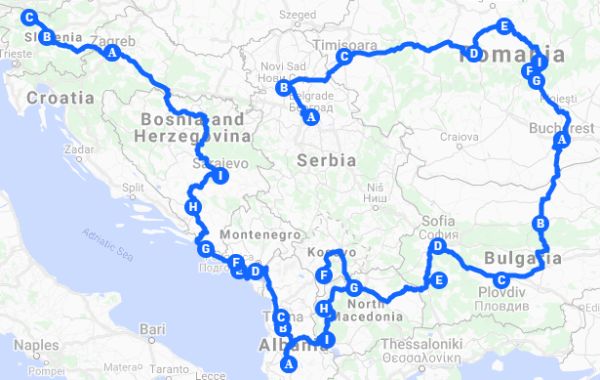
Day 1 – Belgrade, Serbia
3 weeks / 21 days Balkan tour starting in Belgrade, Serbia with pick up from any location in the city (accommodation, hotel)
→ City tour of Belgrade Visit the Belgrade fortress “Kalemegdan” (Enduring fortress built in 535 BCE) with a view to Sava and Danube rivers; The Pobednik Monument (Monument inside the Belgrade fortress); Church of the Holy Mother of God / Crkva Ruzica (Serbian Orthodox church located inside the Belgrade fortress); The “Knez Mihaylova” pedestrian street; t. Sava cathedralS (The biggest Orthodox cathedral in the Balkans ); The Republic square, The National Assembly, The bombed buildings.
Day 2 – Novi Sad, Serbia
→ Transfer to Novi Sad, Serbia
→ Novi Sad walking tour Visit the old town and the Petrovadian fortress
Day 3 – Sibiu and Sighisoara
→ Sibiu walking tour Visit the Consul tower of Sibiu, the Large Square, the bridge of Lies, Sibiu Lutheran Cathedral;
→ Sighisoara city tour Visit the Sighisoara Citadel, The Clock tower, Vlad Dracul House
Free time in Sighisoara
Overnight in Sighisoara
Day 4 – Bran and Sinaia castles, Brasov, Romania
→ Transfer to the area of Transilvania Visit the Dracula’s castle (Bran castle) and the Peles castle in Sinaia
Free time in Brasov
Day 5 – Bucharest, Romania
→ Bucharest city tour Visit the Palace of Parliament, Old town, Piata Victoriei, Cec Palace, unirii Square, Revolution square, National Museum of Romanian history, Constitution square, Lui Carol monument, Palace of justice.
Free time in Bucharest
Day 6 – Veliko Tarnovo, Bulgaria
→ Transfer to Veliko Tarnovo, Bulgaria
Day 7 – Plovdiv, Bulgaria
→ Transfer to Kazanlak area via the Shipka pass Visit Etar complex and the Kazanlak Thracian tomb Golyama Kosmatka
→ Transfer to Plovdiv, Bulgaria
Day 8 – Sofia, Bulgaria
→ Walking city tour of Sofia Visit the Historical center of Sofia and the most interesting sights in the area. Visit the St. Nedelya square; Nedelya church; St Sofia Monument; St. Petka Church; The old Serdika Ruins; The mineral springs; The council of ministers; The Rotunda “Saint George”; The Presidency; The mosque “Banya Bashi”; The National archaeology museum (not going inside); The National Bank of Bulgaria; Knyaz Alexander Battenberg Square; The King’s palace; The Russian church; St. Sofia Church; The National Theater; The Monument of the “unknown soldier”; The Alexander Nevski Memorial Church; The city garden; The museum of Sofia.
Day 9 – Rila monastery, Bulgaria – Skopje, North Macedonia
→ Transfer to the Rila monastery Explore the biggest monastery complex on Balkans
Day 10 – Prizren, Kosovo
Day 11 – mavrovo area, north macedonia.
→ Transfer to Mavrovo area, North Macedonia Visit the St. John the Baptist monastery
→ Transfer to Ohrid, North Macedonia at late afternoon
Day 12 – Ohrid, North Macedonia
Day 13 – berat, albania.
→ Transfer to Berat, Albania Visit the old part of town and the fortress
Overnight in Tirana, Albania
Day 14 – Tirana, Albania
→ City tour of Tirana in the morning Visit the “Skanderberg square” (The main square in Tirana) with the Skanderberg Statue; the “Ethem bey” mosque (the Only historical mosque in Tirana) the “Enver Hoxha” pyramid, the Peace bell, the Building of the historical museum of Tirana, a Preserved bunker (In one of the bunkers there is a museum about the victims of the Albanian Communist regime) Maria Theresa boulevard, the University of Tirana, the Old government square; The Clock tower (19th Century)
Day 15 – Kruje, Albania and Skadar Lake, Montenegro
Day 16 – kotor, montenegro.
→ Transfer to Kotor, Montenegro
→ City tour of Kotor Old Town Visit the Kotor old city, Kotor harbour, city walls, St Tryphon cathedral, St Nicola church, Piaza of the arms, Church of St Luke, Gurdich gate, Clock tower, Grubonja palace, Karampana well, Drago palace, Pima palace, Beskuca’s Palace, Grgurina Palace, Bizanti Palace, Prince’s Palace, Sea gate, Old Kotor prison building
→ Transfer to Dubrovnik, Croatia Free time in Dubrovnik, Croatia
Overnight in Dubrovnik, Croatia
Day 17 – Dubrovnik, Croatia
→ Dubrovnik city tour in the morning Visit the Old town, the Ancient city walls, the Dubrovnik “Saint Saviour” church (16th century church with Renaissance architecture); the Dubrovnik cathedral (Early 18th-century baroque cathedral); The Onofrije’s fountain, The Franciscan Monastery (Landmark monastery built in the 1300s, noted for its cloister, library & historic pharmacy displays); the Gates of Pile; the Old port; the Clock Tower, the Sponza Palace, the Rector’s Palace; the Fort Saint John; the Stradun (The main walking street in Dubrovnik old town);
Day 18 – Mostar, Sarajevo, Bosnia
Day 19 – sarajevo, bosnia.
Overnight in Bosnia
Day 20 – Zagreb, Croatia
→ Long transfer to Zagreb, Croatia
→ City tour of Zagreb, Croatia Visit the Old Town; The Zagreb Cathedral; St. Mark’s church (Monumental, medieval-style, Serbian Orthodox church); Dolac Market (Large market with many stands offering flowers, fruits, veggies & meats in an indoor/outdoor setup); The Lotrscak Tower; The Medieval Stone Gate; The Lenucijeva Potkova. Ban Josip Jelačić Square (The central square of Zagreb)
Overnight in Zagreb, Croatia
Day 21 – Ljubljana, Slovenia
→ Transfer to Lake Bled, Slovenia
→ Explore the lake and the area
→ City tour of Ljubljana The Dragon Bridge; Tromostovje (The Triple Bridge is a group of three bridges which connects the historical part of Ljubljana with the modern part of the city); Preseren Square (The central square in Ljubljana part of the old town’s pedestrian zone), Franciscan Church of the Annunciation (17th-century Franciscan church famous with its interior). Robba fountain (18th-century fountain made of limestone and marble); The Butcher’s bridge; The town square; Ljubljana Town Hall; The city market of Ljubljana; The Ljubljana cathedral (Roman Catholic cathedral with a baroque interior, including gilded columns & ceiling frescoes).
→ Free time in Ljubljana
Get a free quote on your Balkan travel itinerary – or let us build yours for you today. All you need to do is send us a few details via email or the form and we’ll get right back to you.
LET'S START PLANNING YOUR TOUR!
Our tours are private and customized around your interests
Number of passengers 1 2 3 4 5 6 7 8 8+
Desired itinerary
Include accommodation in the price estimate? Yes No
Accommodation level 5 star 4 stars 3 stars 2 stars
Please prove you are human by selecting the house .
Where next?
- Bosnia and Herzegovina
- North Macedonia
Introducing the 6th Productive Muslim Retreat!
Experience the Art of Resiliency in Bosnia
Registration for the productive muslim retreat in bosnia is now closed., please add your name to the waiting list if you’re interested to join our upcoming retreats..
Life is a test. How will you deal with it?
We live in a world that is full of tests.
Some tests affect us personally. Others affect our family. And then, some tests occur at a societal level and impact everyone we know.
The story of Bosnia is a story of a small nation that went through an extremely tough test: War, siege, and genocide.
However, just like every life test, how we react to this test matters more than the test itself, and Bosnia can teach us a lot about how to pass tests with faith and perseverance.
The Productive Muslim Company is excited to host our 6th Productive Muslim Retreat in Bosnia with the theme, "The Art of Resiliency" from the 14th to the 21st of May.
This is a group coaching journey of personal growth and healing.
For seven days, you'll explore this vibrant nation's rich culture and natural beauty while working on learning how to develop resiliency in your personal and professional life.
You'll connect with like-hearted individuals from all over the world and have the opportunity to immerse yourself in the beauty of Bosnia while also focusing on your personal growth.
During the retreat, you will participate in a variety of workshops, group coaching sessions, and one-on-one discussions focused on the following themes:
- Building resilience and inner strength
- Developing Shukr and Sabr (Gratitude and Perseverance) regardless of your circumstances
- Cultivating healthy habits and routines to master resiliency
Don't let the demands of your life hold you back from this opportunity. Join us on this special Productive Muslim Retreat and start your journey towards a more fulfilling and productive life.
We can't wait to see you in Bosnia!
What are Productive Muslim Retreats ?
Productive Muslim Retreats are an opportunity for you to get away from the distractions of life and immerse yourself in learning, exploring, and connecting with other like-hearted Muslims about what it means to live a meaningful life that is full of Barakah.
They are experiential journeys where we create safe environments for you to:
- Discover and learn about yourself
- Connect with like-minded people
- Be inspired to be a better version of yourself
This is our 6th retreat and our first time hosting the retreat in Bosnia.
We look forward to welcoming you on this inspiring journey.
What’s the itinerary of this retreat?
Day 1 - welcome to sarajevo, sun, 23 shawwal 1444h (14 may 2023).
Arrive in the morning or early afternoon and enjoy lunch at a local restaurant with some world-famous Bosnian Kebab.
Take a walking tour of Sarajevo Old Town and discover the Waqf of Gazi Husref Bey.
In the evening, we'll have a formal welcome dinner followed by Maghreb/Isha at an Old Town Masjid.
Day 2 - Discover Sarajevo
Mon, 24 shawwal 1444h (15 may 2023).
We'll start our day with Fajr prayer in congregation, morning reflection, athkar, and breakfast. This will be the daily practice throughout the retreat.
We'll then have our first Art of Resiliency workshop by our instructors.
After the workshop, we’ll complete the Bosnian War Tour, covering:
- The spark for World War 1 — the Assassination of Franz Ferdinand
- Siege of Sarajevo Tour (1992-95) — including Shaheeds Cemetery, Alija Izetbegovic Museum, Yellow Fortress, Sarajevo Roses, Markale Market
In the evening, we'll have an expert lecture on the History of Islam in Bosnia and the Balkans.
Day 3 - Herzegovina Tour (Konjic, Mostar, Blagaj, Skybridge)
Tue, 25 shawwal 1444h (16 may 2023).
After our morning routine, we'll have the second session of the Art of Resiliency workshop by our instructors before we head out to visit Mostar, a UNESCO Heritage City, where we'll visit:
- Stari Most Bridge
- Mehmed Koski Pasha Masjid
- Karadoz Bey Masjid
We'll then proceed to Blagaj village for a tour and dinner before spending the night at Mostar.
Day 4 - Herzegovina Tour (Pocitelj, Stolac, Village)
Wed, 26 shawwal 1444h (17 may 2023).
In the morning, we'll visit two UNESCO Heritage towns: Pocitelj & Stolac. We'll have walking tours of both cities discovering the mosques, clock towers, fortresses, and unique architecture. We'll also visit the International House of Reconciliation.
We'll have a practical workshop on Bosnian cultural heritage crafts in the afternoon. We will spend some time with Muslim villagers in town and try out local products before returning to Sarajevo.
Day 5 - Olympic Mountains
Thu, 27 shawwal 1444h (18 may 2023).
We'll spend the first half of the day with our instructors with a third session on the Art of Resiliency. After the workshop, we'll head to the Olympic Mountains, where the Winter Olympics took place in 1984.
We'll have lunch at a beautiful mountaintop hotel before returning to Sarajevo for the evening.
Day 6 - Sarajevo
Fri, 28 shawwal 1444h (19 may 2023).
Back in Sarajevo, we'll have the last session of the Art of Resiliency workshop followed by a relaxing walk in the pine forest park of Bosnia River.
We'll visit the war tunnel with a local imam before proceeding to Trebevic mountain to see the front lines of the Sarajevo siege.
Day 7 - Srebrenica
Sat, 29 shawwal 1444h (20 may 2023).
We'll leave early in the morning from Sarajevo to visit the Potocari Genocide center.
We'll hear stories from survivors, Imams, and community leaders on the impact of the genocide on their lives and how they've persevered through the trial.
We'll head back to Sarajevo for a dinner and official wrap-up session before departing the next day after Fajr insha’Allah.
The order of sightseeing described in the tour program above may vary depending on weather conditions, changes in the opening hours, and other circumstances.
Who are the instructors for this retreat?
Hafsah Adham
FOUNDER, THE CONFIDENT MUSLIMAH
Hafsah Adham is a confidence coach, public speaker, community worker, entrepreneur and mother of three.
Her confidence coaching is intertwined with the guidance from the Qur’an and Sunnah designed to propel you to be more, do more, and give more.
With years of experience in delivering talks, running workshops, and coaching people worldwide, she has a proven ability to help others step into their best version and rise above daily challenges with courage and gratitude.
She is most passionate about building the next generation of Muslim leaders who—like the companions—are confident, courageous, and Jannah-focused so they can take positive action towards their personal and professional goals with long-lasting confidence.
Hafsah is based in the UK. She’s an adventurer at heart with a passion for sports.
Mohammed Faris
FOUNDER & CEO, THE PRODUCTIVE MUSLIM COMPANY
Mohammed Faris is an executive coach, author, and speaker who helps professionals and teams connect spirituality to productivity. He holds an MSc degree from the University of Texas at Dallas (USA) on Leadership and Organizational Development as well as an MSc degree from the University of Bristol (UK) in Finance and Investment. He is the founder of The Productive Muslim Company and the author of the best-selling book, "The Productive Muslim: Where Faith Meets Productivity." Mohammed has delivered seminars and workshops in over 15 countries and featured on international media and the TEDx stage. He regularly speaks at Fortune 500 companies & major Islamic Organizations, including Google, American Airlines, Salesforce, Texas Instruments, Accenture, PWC, and the Islamic Development Bank Group.
Additionally, the instructors will be supported by a team of local English-speaking guides and a Halal Trip representative to help you with any logistical concerns.
What will you learn during the retreat?
The retreat is more than just a tour of Bosnia, it's a coaching experience with workshops, activities, and group sessions to ensure that you can translate what you're experiencing during the retreat into your personal and professional life. Some of the topics we'll cover include:
- How to experience Shukr (gratitude) in every struggle.
- How to live in this world as a purposeful and productive traveler despite its challenges.
- How to set long-term goals like a gardener even if you don't know the future.
- Practical ways to develop resilience in your personal and professional life.
Some of the activities we'll conduct during the retreat:
SHUKR CIRCLES
MORNING & EVENING REFLECTIONS
GRATITUDE JOURNALING & MORE!
Book today—don’t hesitate!
The Productive Muslim Retreat is the perfect opportunity to hit the reset button and refocus on your personal growth. By taking time out to reflect and recharge, you'll return to your personal and professional life with a renewed sense of purpose and the tools you need to manage stress and stay focused.
Not only will you benefit personally from this retreat, but the skills and strategies you learn can also have a positive impact on your professional life.
So don't wait any longer—join us at and start your journey towards a more fulfilling and productive life. We promise that you won't regret it!
1. What is the Productive Muslim Retreat?
The Productive Muslim Retreat is an annual retreat that brings together like-minded individuals who want to be a better version of themselves through travel and unique experiences. We’ve held five retreats so far, one in Sri Lanka, three in Indonesia, and one in Uzbekistan. This is our sixth retreat in Bosnia insha’Allah.
2. Is the retreat family-friendly?
This trip can be an inspiring experience for the whole family. However, please note that this retreat does involve a lot of walking and long day tours, hence please plan accordingly. If you are interested in taking your child, please contact Halal Trip team to discuss pricing and accommodation.
3. How quickly do trips fill up? Is there a deadline for booking?
Pretty fast! Since reservations are confirmed on a first-come, first-served basis, we recommend that you talk to us if you are interested in a trip but not quite ready to book. Single accommodations are frequently limited. To check on availability, please email [email protected] .
4. How do I register for a trip?
You may register by completing this online registration form and we will reach out by phone/email for your deposit information.
5. Is airfare included in the cost of the program?
Airfare from your home city to the destination is NOT included in the trip price.
6. What happens after I book?
- Welcome session: 1 month before the retreat, you’ll be invited to a welcome training session on how best to prepare for the retreat.
- Info session: 10 days before the retreat starts, you’ll be invited to an info session to meet fellow participants and go over the logistics of the trip.
- WhatsApp group: 1 week before the retreat, we’ll create a WhatsApp group for all participants to share time-sensitive information before the retreat starts and during the retreat.
7. Can I skip part of the trip?
There is some flexibility to opt-out of certain activities; however, since trips are sold as a full package, portions cannot be paid for à la carte. If you arrive late to a trip or must depart early, we are not able to provide refunds for unused portions of a trip.
8. How active is the retreat? And what are the physical and health requirements?
You should be in good overall health and able to walk up to three miles over the course of a day and stand for periods of time in museums and at historic sites. There will be long days of traveling and sightseeing, moderate hikes on uneven terrain, and some walking up hills or stairs without handrails. Travelers should also be able to embark and disembark the motor coach without assistance.
9. Is the retreat accessible to people with disabilities?
Don't hesitate to contact our team to discuss your needs and the details regarding limitations; we will work to determine if the program is right for you. Many trip itineraries can be challenging for those with physical limitations—rigors can include cobblestone streets, uneven stairs with no railings, etc. Some historic sites have very limited access for those with impaired mobility, providing few benches or rest stops. Anyone requiring significant assistance should bring a traveling companion, who will be responsible for providing support.
10. What is the cancellation policy?
If you cancel your booking:
- More than 30 days from the retreat date, you will receive a full refund.
- From 15 days to 30 days from the retreat date, 50% refund.
- Less than 15 days from the retreat date, no refund is granted.
Travelers are bound to the published cancellation policy after registering for a trip.
11. Do you provide trip insurance?
We recommend that travelers purchase trip medical/cancellation insurance to cover the risks of trip medical or cancellation expenses.
©1444H/2023. The Productive Muslim Company. All rights reserved.
Terms of Service | Privacy Policy

IMAGES
COMMENTS
Bosnia Tour: Trip Highlights. What you'll experience on our mixed group Bosnia Islamic tour. Rafting adventure on the Neretva River OR 4x4 Adventure to the mountains. Walk up the minaret of the Koski Mehmet Pasha Dzamija. Lunch and prayer at scenic Blagaj Dervish Lodge. Walking tour of the Bascarsija in Sarajevo and Old Town in Mostar.
Bosnia-Herzegovina is a beautiful country that has been recovering strongly since the war of the mid 1990s. Amongst its jewels is an abundance of mountains, forests, rivers, waterfalls, hospitable people and 600 years of Islamic civilisation in the heart of Europe. This heritage tour takes us to places of Islamic, historical and cultural ...
8 Days Halal Holiday. 635 EUR / per person. Our 8 days Green Bosnia package offers the best way to explore the most important sites in Bosnia and Herzegovina with the respect of the halal voyage. Booking the 8 days Green Bosnia package is possible everyday during the year. Our travel consultants will give you detailed information about the ...
The tour takes place in the old town in Sarajevo and includes a visit to a mosque, tekke (dervish house), a traditional Muslim family house, a cemetery and ends with traditional Bosnian coffee/tea. All questions that you have about Islam and Bosnia will be answered by our informative and patient tour guides. 3 hrs. Entrance fee to Gazi Husrev ...
Book your place with Ibadah Tours today. Our team in London will be happy to help you find the right package. 020 8004 6786. [email protected]. All the flights and flight-inclusive holidays on this website are financially protected by the ATOL scheme. When you pay you will be supplied with an ATOL Certificate.
Day 1 - Welcome to Bosnia. Depending on where you are in the world, you may have access to direct flights to Sarajevo. Budget flights with WizzAir from London-Luton Airport to Sarajevo now fly twice weekly, for example. Another fast and value for money route is by landing in Croatia, specifically in Split or Dubrovnik and then crossing the ...
Itinerary. TOUR HIGHLIGHTS: DAY 1 - Arrival to Sarajevo International Airport and transfer to the hotel. DAY 2 - Visiting spring of the river Bosna, Tunnel of Hope and Old Town Bascarsija. DAY 3 - Visiting Jablanicko lake, Old Bridge in Mostar city and spring of the river Buna. DAY 4 - Visiting Travnik city, the lakes and waterfalls in Jajce city.
Mostar is a picturesque city in Bosnia and Herzegovina that is quite literally split into two religions—Islam on one side of the river bank and Catholicism on the other. The bridge pictured here, for which the city is named after, is a great example of Islamic architecture in the country. 6. Plivska Lakes.
Discover Bosnian and Herzegovinian culture and have a wonderful rest with Bosnian Halal Travel. Select the cities you would like to visit and provide us with estimated time. We will find and offer the most suitable tours and hotels. During our work, we organized countless journeys for our clients. We started as a small tour bureau, and soon we ...
With more than five centuries of Ottoman history and a Muslim-majority population, modern Bosnia and Hercegovina brims with Islamic heritage. This land of Grand Viziers, magnificent imperial mosques and delicious Muslim cuisine is the perfect place to get a deeper understanding of the history and influence of Islamic culture in Europe.
Starting off with a quick introduction with your tour guide, you will be taken through an overview of the Islamic religion, including its beginnings and evolution. From tradition to culture, from social relations to everyday life, you can discover the religion of Islam. You will learn the history of Islam in Bosnia and Herzegovina, and how much ...
Halal Travel Guide | Curating the best in Muslim-friendly travel | Our passion is creating exceptional group tours designed with Muslim travellers in mind. ... Experience the thrill of a lifetime on our Outdoor Adventure tour in the captivating landscapes of Bosnia! BOOK NOW. Learn More. From . £795. UZBEKISTAN . Thursday 2nd May - Saturday ...
Visit the most beautiful sights like the capital Sarajevo, and cities like Mostar and Travnik or even unusual places like Lukomir Village or Bijambare Caves. Besides all of the beautiful nature and great people, in Bosnia and Herzegovina, you can find halal tourism offers like hotels, restaurants, Muslim guides and facilities to pray. Mostar.
The house is a national landmark; don't miss the daily guided tour at 10 a.m. Information: ... a Croat and a Bosniak (or Bosnian Muslim), not a Serb, a Croat and a Bosnian.
Bosnia & Herzegovina as a Muslim-friendly destination. Muslims, also known as Bosnian Bosniaks, comprise roughly half of the population in Bosnia, making them the largest single religious community within the country. ... The next day, you could make a day trip to Blagaj by bus or hop on a tour that combines Blagaj with the medieval town of ...
Srebrenica is a small town with a population of 2,604 inhabitants located in the eastern most part of Bosnia & Herzegovina and is still remembered for the Srebrenica massacre, also known as the Srebrenica genocide. In July 1995 genocide of more than 8,000 Bosniaks, mainly Muslim men and boys took place.
A Muslim-friendly tour of Bosnia & Herzegovina is the perfect excuse to take a fascinating trip to Southeastern Europe. This region of The Balkans has become a popular tourist destination with much to offer Muslim travelers when it comes to Halal holidays in Bosnia & Herzegovina - not to mention interesting historical and cultural experiences too. . Planning a trip to Bosnia & Herzegovina is ...
Breakfast. After hotel check out, we will proceed to Jajce.Start the City Sightseeing Tour of its Old Town and shopping at Jajce Bazaar. The panoramic tour includes the Fortification System, Buric's house, Women's Mosque, Esmo Sultanija Mosque, Royal Grave, Jajce and its Ancient District, Musafirhana, Necropolis with Stecci in Vinac, Omer-bey's House, Watermills Complex on Pliva Lakes ...
Almir's hope-filled tour of Bosnia's difficult past. ... Multiethnic Bosnia is mainly made up of Muslim Bosniaks, Orthodox Serbs and Catholic Croats; during the war, it was the Bosniak population that fell victim to what is widely today considered ethnic cleansing by the Serb forces. Sarajevo today remains a majority Bosnian Muslim ...
Day 5 - Prizren, Kosovo. → Depart from Skopje after breakfast. → Transfer to Prizren, Kosovo via the mountain road. → Walking tour Prizren. Visit the city center; Our Lady of Ljeviš Church (14th-century Serbian Orthodox church); Sinan Pasha Mosque (17th Century mosque) → Transfer back to Skopje. Overnight in Skopje.
In the 2013 census the declared religious affiliation of the population was: Islam (1,790,454 people) and Muslim (22,068 people). Islam has 1.8 million adherents, making up about 51% of the population in Bosnia and Herzegovina. PEW survey says that there are 52% Muslims in Bosnia and Herzegovina. [4]
The Productive Muslim Company is excited to host our 6th Productive Muslim Retreat in Bosnia with the theme, "The Art of Resiliency" from the 14th to the 21st of May. This is a group coaching journey of personal growth and healing. For seven days, you'll explore this vibrant nation's rich culture and natural beauty while working on learning how ...
We explored Sarajevo's old town, ate cevapi (balkan kebab), meat pies and baklava while musing over football, war and the origins of food.#Sarajevo #Bosnia #...